If you have been an avid reader of the Gentleman’s Gazette, you might notice that when we talk about men’s shoes, the brand Allen Edmonds always comes up. It is among the more popular American brands and has been around since the 1910s. So, today, almost a century after, we dissect their offerings from over 50 years to find out their true value!
*Note: Be sure to watch today’s video to understand all the nuances of the deconstruction process!
Video Transcript [Lightly Edited for Clarity]:
Sven Raphael Schneider: Welcome back to the Gentleman’s Gazette. In our series “Taking It Apart,” today, we will be taking apart four pairs of Allen Edmonds shoes.
“Why would you do that,” you might ask, considering that we’ve already done an “Is It Worth It?” for Allen Edmonds.
Well, as you might know, ownership of Allen Edmonds has changed a few times over the last few decades and some people argue that the quality has deteriorated over time. By cutting them all apart and comparing them side-by-side, we can really understand what has changed and if that was a change for the better or for the worse.
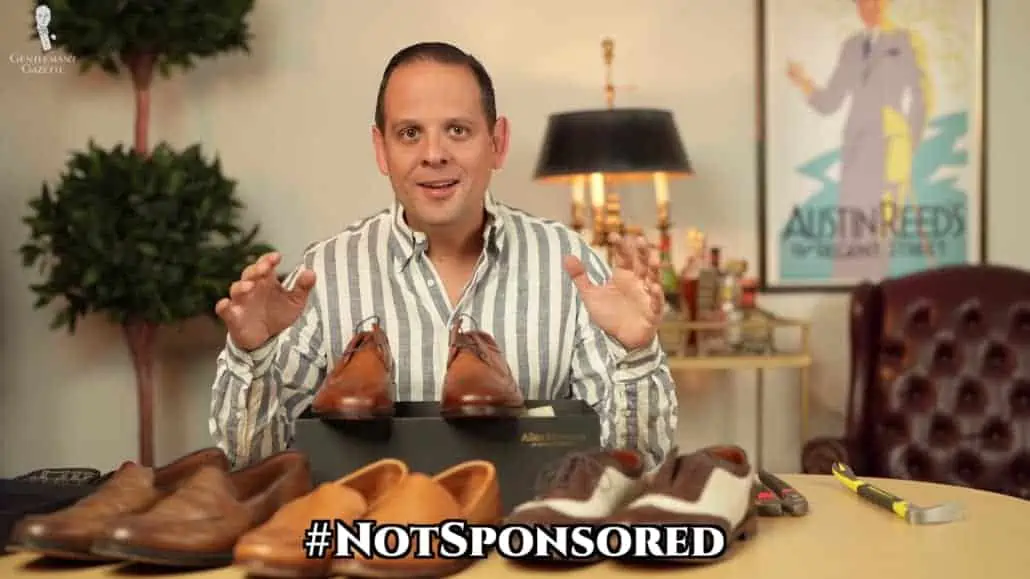
We bought all the shoes for the video. There is no sponsorship. Nothing was paid for. This is 100% our own true, unbiased opinion.
1. Heel Blocks
1A. Shoe from the 2010s
So, first, we want to take off the sole and start with a heel block. With allotments, typically in the newer ones, they all had a solid rubber block. Alright, you can see here, this is the rubber heel block. You can see their nails, their nails in there, in the heel. So, it’s basically nailed down.
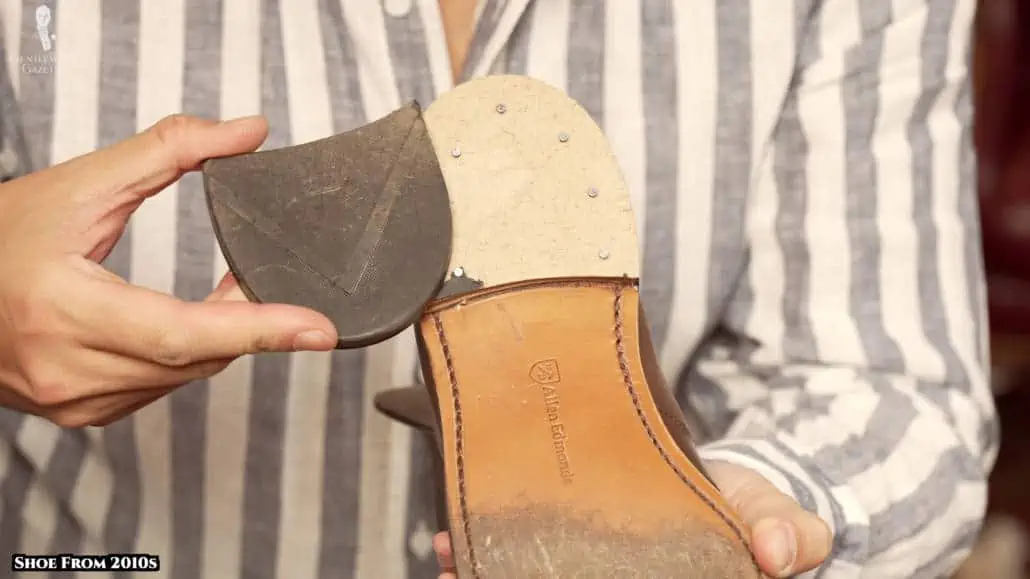
If you look here, the heel is some sort of leather. You can see your little edge, meaning there are different layers of leather. I don’t know if they buy it like that and then just add it to the shoe in one piece, which is, I think, what they do. I don’t think they’ll build up a leather heel one layer by layer as they would do at a custom shoemaker.
All right, here’s the heel block. So, there’s one, two, three, four, five, six, seven nails. One, two, three, or four layers of leather basically.
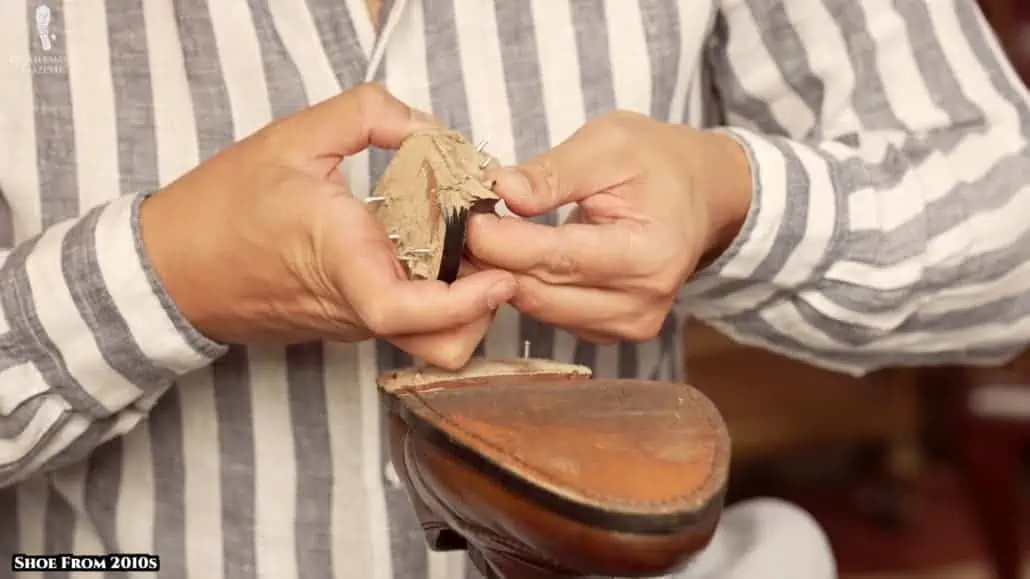
1B. Shoe from 2021 – Grandview Longwing Derbys
All right, let’s take apart the newest model from the current ownership with the new branding, and this one here is a Grandview model in walnut leather.
You can see the stitching is not quite perfect, so there’s a little bit like a smudge on the sole. I think this is a second, but it’s made the same way as the prime, first-grade quality. So, let’s take a look.
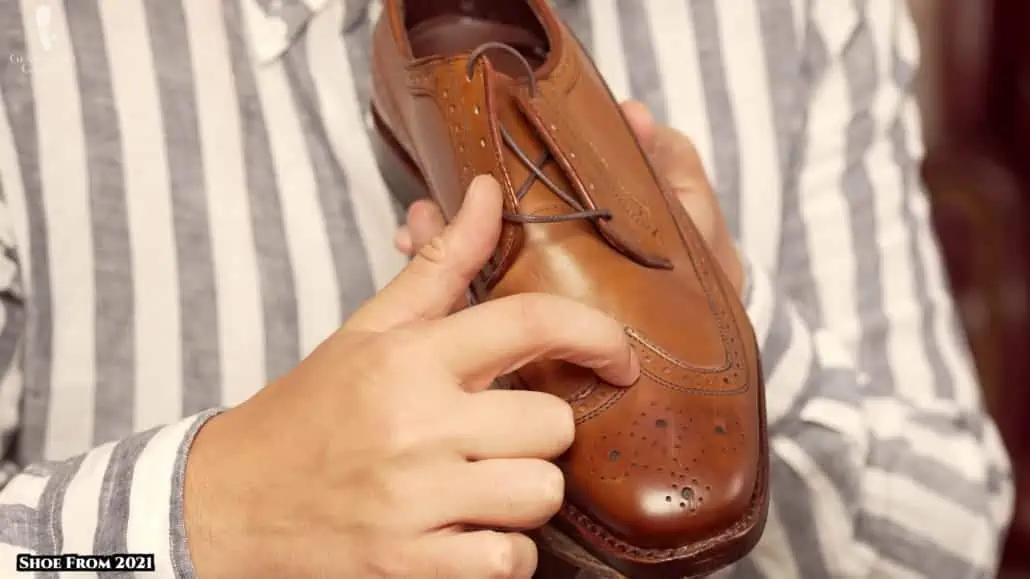
Okay, the heel looks pretty similar to the old ones. It just doesn’t have the AE branding on it.
Now, the leather heel again, we have these seven nails here. Pretty much like before. Okay, leather material seems to be very similar to what we had before.
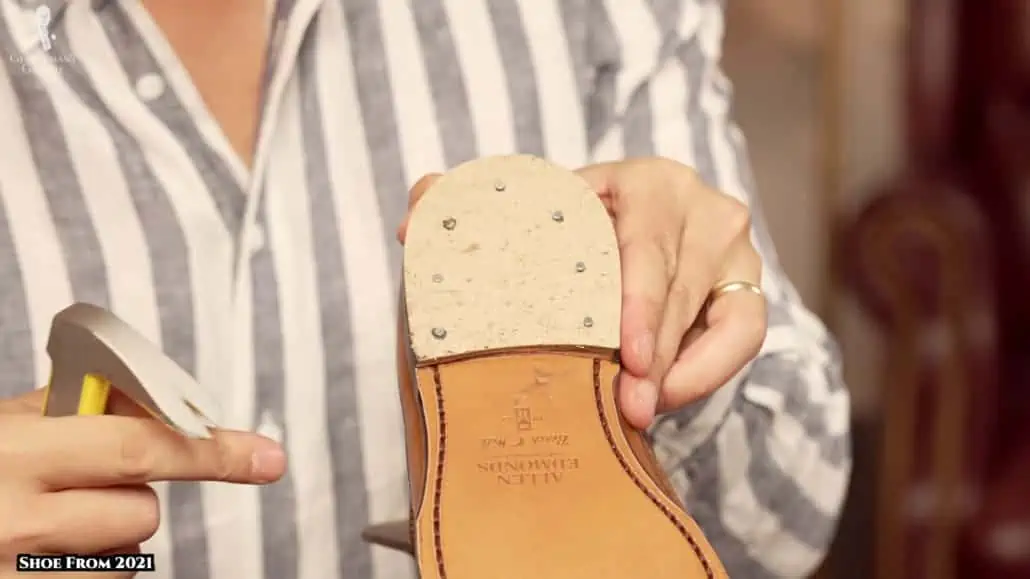
1C. Shoe from the 2000s – Sanibel Loafers
All right, now, let’s take apart this Sanibel loafer. It is the second oldest of the new shoes we have, and it’s slightly different from some other elements.
First, if you look here you don’t see the welt stitching, it’s concealed but it’s still a Goodyear-welted shoe, and, second here, you have that moccasin toe construction, similar to the other loafer, and you could even see here that the thread was flamed off. Must be synthetic of some kind, which is fine. It’s durable.
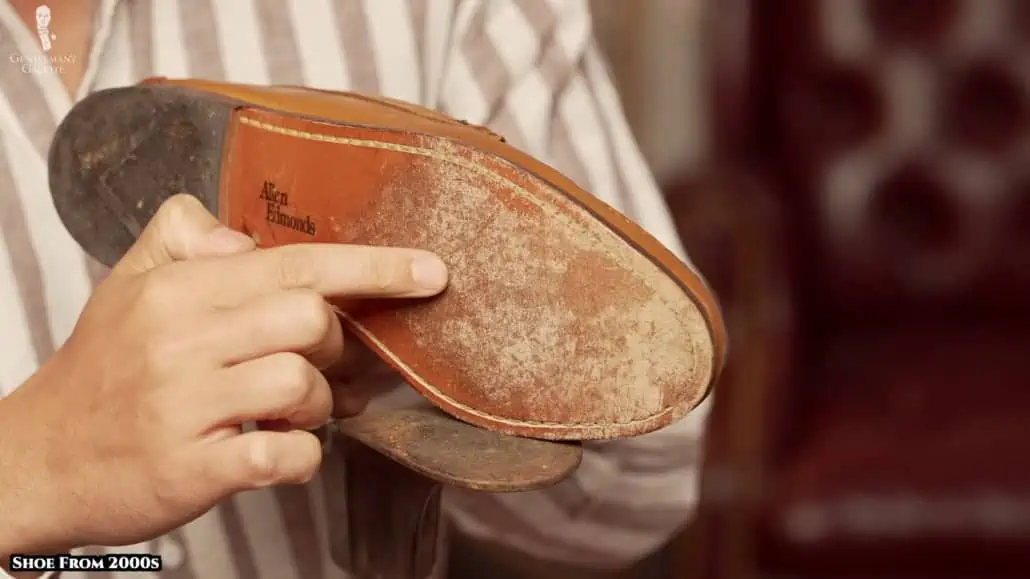
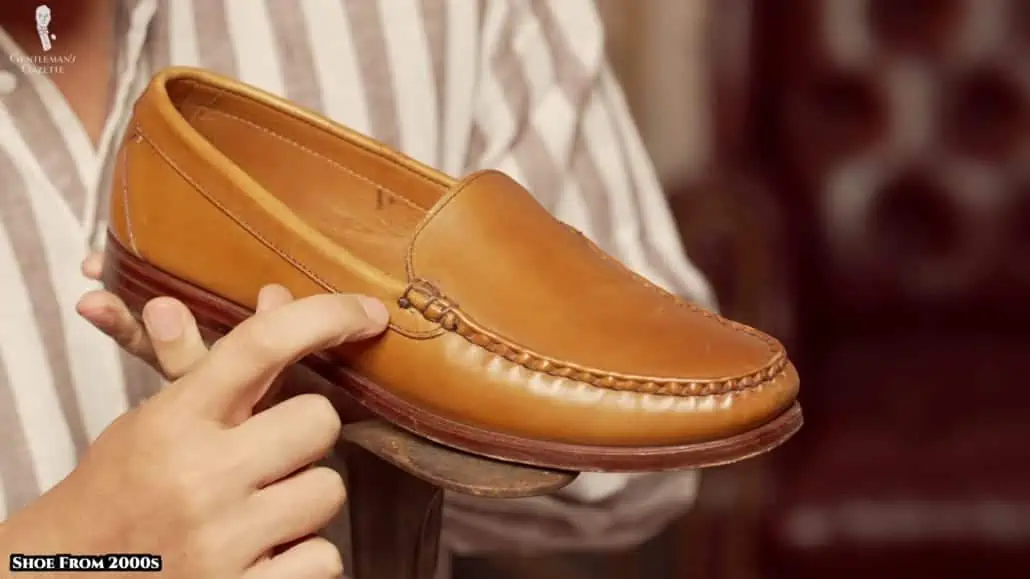
When I was at Allen Edmonds in Port Washington, they said that all of that hand stitching is done in the Dominican Republic, yet the whole shoe is still always marked as “Handcrafted in the US,” so I thought it was an interesting side note.
In here, you can see it says “No Warranty,” so it assumed this was a second, and it was stamped that way at the time.
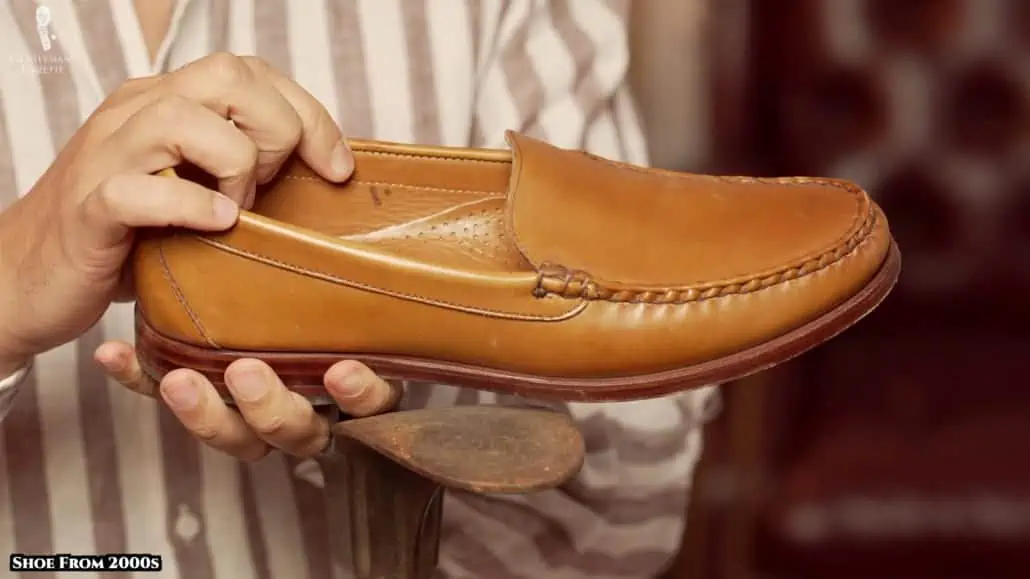
Okay. Same looking Allen Edmonds rubber patch and they also kind of angle that because the idea is that, when you walk, the inside corner doesn’t get caught in your cuffs or turnips.
So, now, this is interesting. If you see here, there’s a little nail, but definitely not the nails that we’re used to seeing otherwise. Looks like a compressed kind of fibrous leather. It’s interesting. Not like a top grain for sure.
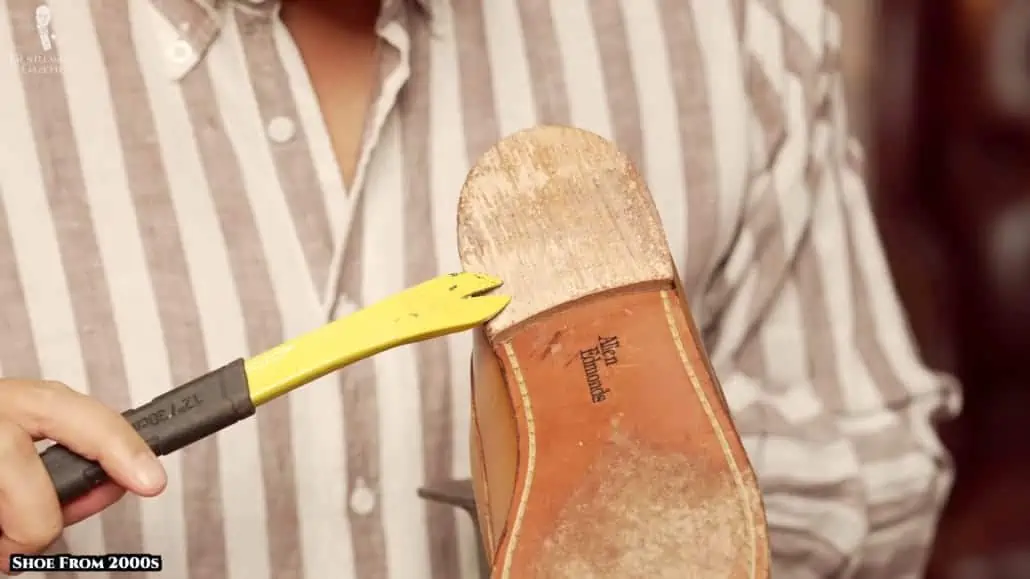
Now, here, you can see there are some nails in here, but they’re nailed in the other way. They’re nailed in top-down, not bottom-up.
All right, the next layer here, very similar to the top one. You can see it’s, like, layered in here so, to me, it seems like this is a compressed leather product in the heel as well, but maybe of slightly higher quality than what we had before.
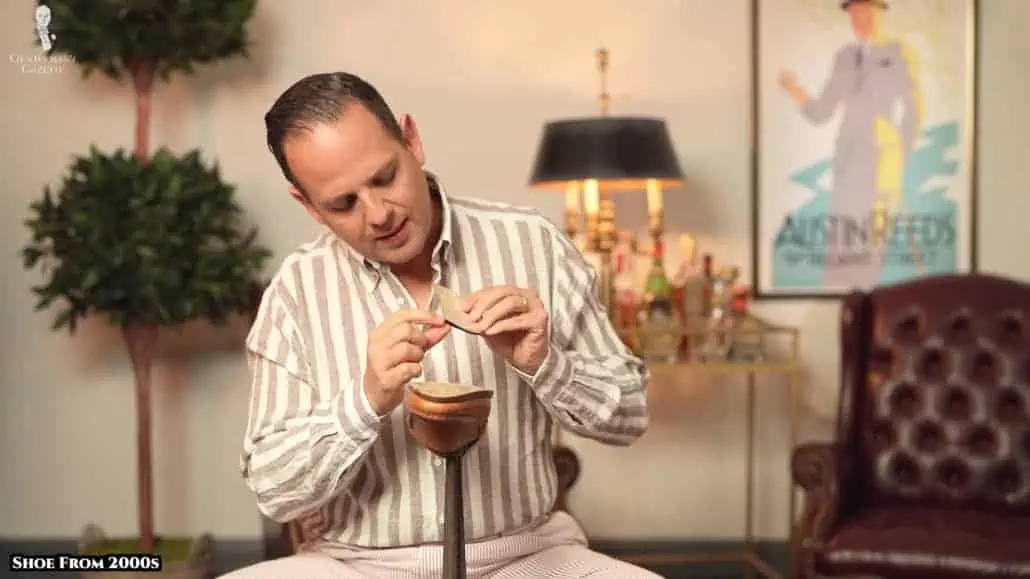
1D. Shoe from the 2000s – Strawfut Oxfords
Here we have the oldest ones of the modern Allen Edmond shoes. And it’s kind of funny if you look here. It’s a slight the broguing piece is still stuck in there after all this time.
The model is called “Strawfut.” You can see the inside sole still has the kind of slightly older Allen Edmonds logo, which is the same as on the sole. The next one had the same kind of sole logo, but a different inside one. That’s why this is a little older and it’s also, as you can see, it’s kind of a spectator with some canvas. So, I’m just curious to see what we’ll have here.
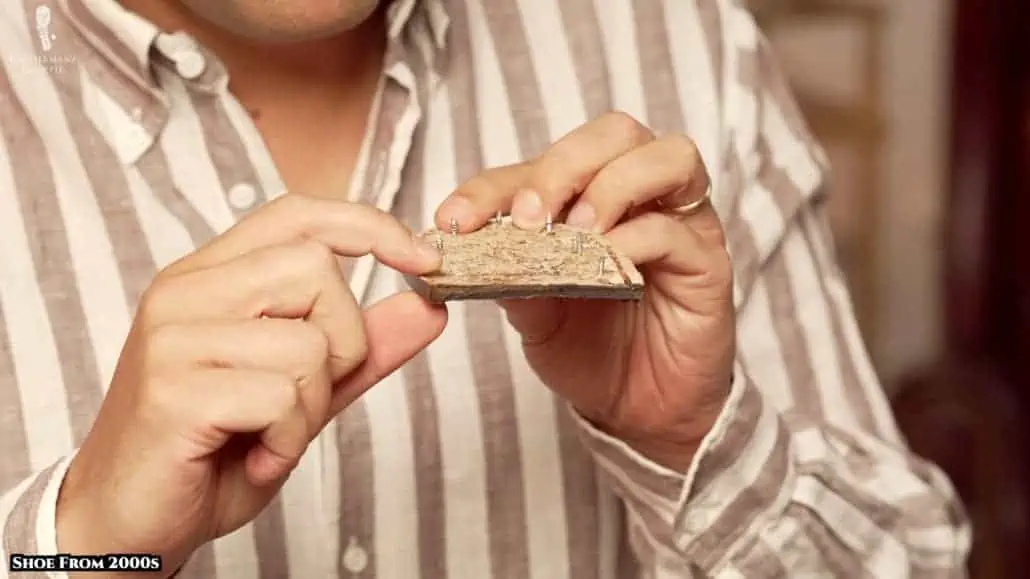
Yep, looks very much the same again. Allen Edmond’s rubber heel here. All right. Seven nails here again and you can see the typical, kind of, thicker-on-the-outside, thinner-on-the-inside. Looks more like cardboard, but it still feels a bit like leather. You still can recognize the layers.
1E. Shoe from the 1970s
Now that we cut open four more modern Allen Edmonds shoes, we’re curious how they changed from back in the day, so we found two pairs here that are originally old.
They have the Allen Edmonds slogan on the inside. Based on the catalog information, this is from the 70s here because it was only produced in the 70s. It’s called the “Biscayne.”
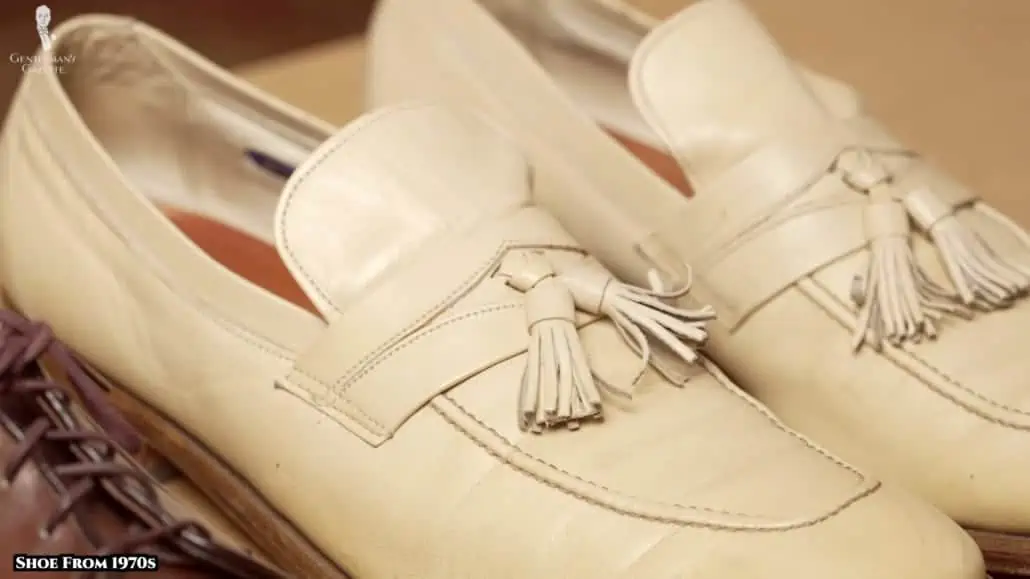
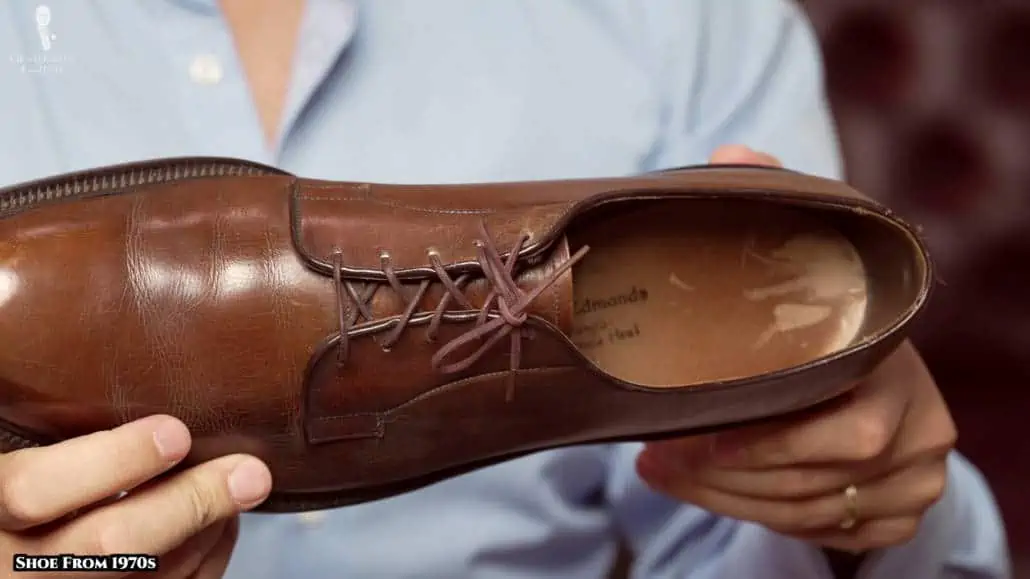
Then we have this model here, which is the “Leeds,” which is, in fact, still available today. I mean, the last has changed, but I mean look at this thick leather sole. Again, Allen Edmonds Ostendo Cushioned Heel. So, we’ll see how cushioned the heel actually is. We’ll take these apart and compare them to the modern ones. So, without further ado, let’s get started here.
Biscayne Moccasins
I’ll start with the Biscayne. The short thing to start is the Elites one has the heel with the “Allen Edmonds” on it. The Biscayne just has a lighter color. They probably didn’t want to use black, but they didn’t have that branded element.
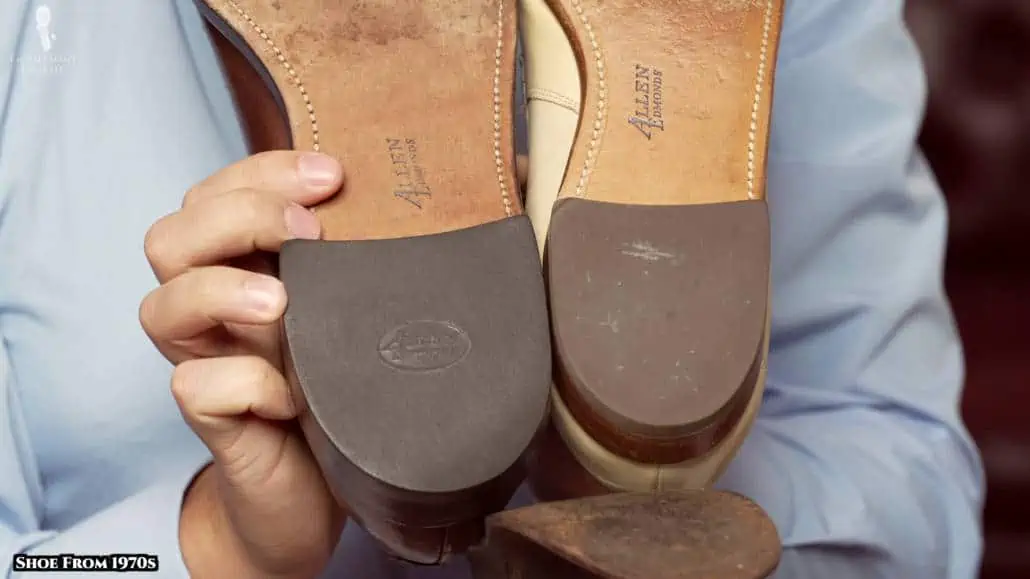
Also, if you look at the Biscayne, the Allen Edmonds labeling, here, it’s pretty center, here, it’s kind of slightly off-center. So, I don’t know if there were seconds, but you can see there’s not much wear on them. They haven’t been re-soled. This is all original old condition, which is pretty cool.
Got my good pry bar here. Glue was still working. Look at that big heel pad. If you look at it here, we still have those seven nails that we saw before. Pretty cool.
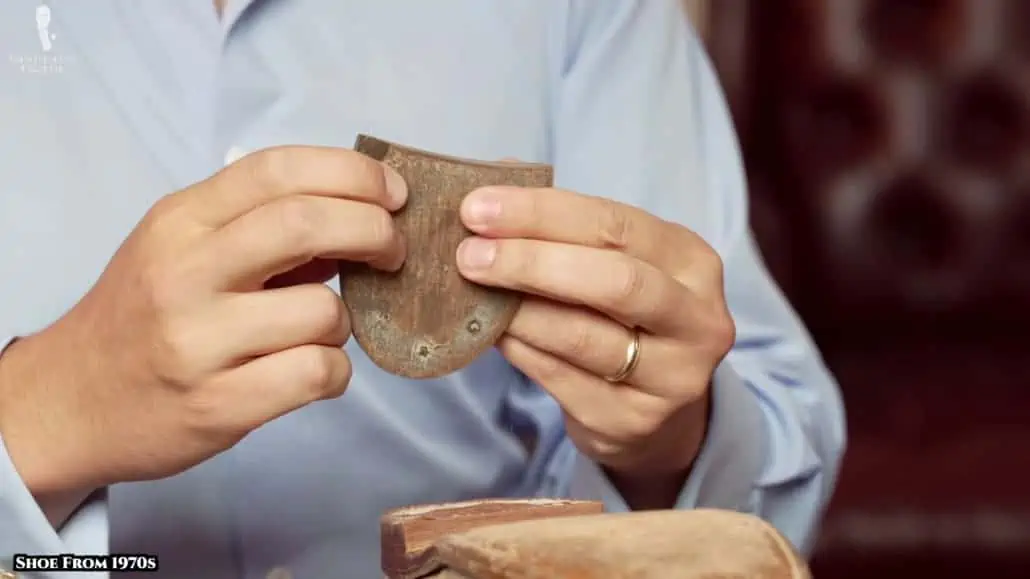
Let’s take the rest of the heel off. Alright, you can see I’m having problems here. The nail just doesn’t come off, but I’ll try if the others come off. Well, we got a nail out here. And look at that, it’s that same kind of riveted nail we’ve seen before. So, pretty impressive they kept it consistent so far in the heel construction.
So, the heel, and I don’t know if they bought it like that or if it was constructed differently, but you can clearly see you had two layers of leather. It seems much more like you know high-quality leather. Of course, it’s drying out over the years, but one, two, and then on top. Because you had the shoe that was curved, right, the heel was also curved. So, it wasn’t a full layer. It was just wrapped around on the side. So, pretty cool.
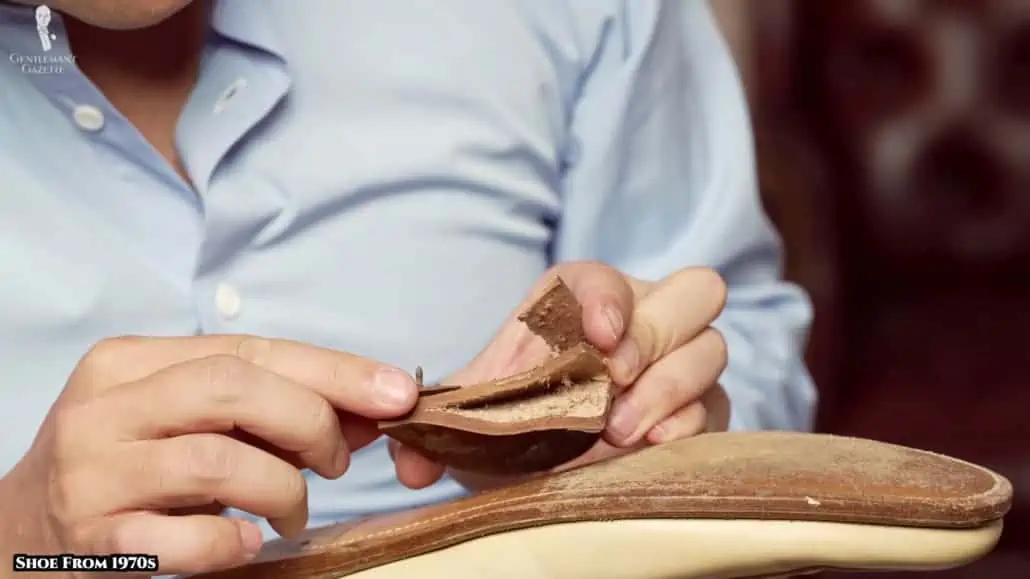
So, this layer, now, comes off like so and then, you see. Even this here – you know I didn’t cut this – this just came apart like that. So, that’s pretty cool.
Leeds Bluchers
Here, we have the Allen Edmonds Leeds. It’s nice leather. I can feel there’s that fabric layer underneath. The leather has a nice kind of soft, cushy touch. Obviously, a thicker sole, they still sell this today, but the last is different and the shape.
It has a little stamp here that says “damaged,” so I assume those were their seconds. I looked around to see if I could quickly see a damaged piece. The other one here doesn’t have it. I’d assume it would be sold as a damaged pair. But, who knows? I mean, they’re constructed the same way in the same factory, so I’m not too concerned about it.
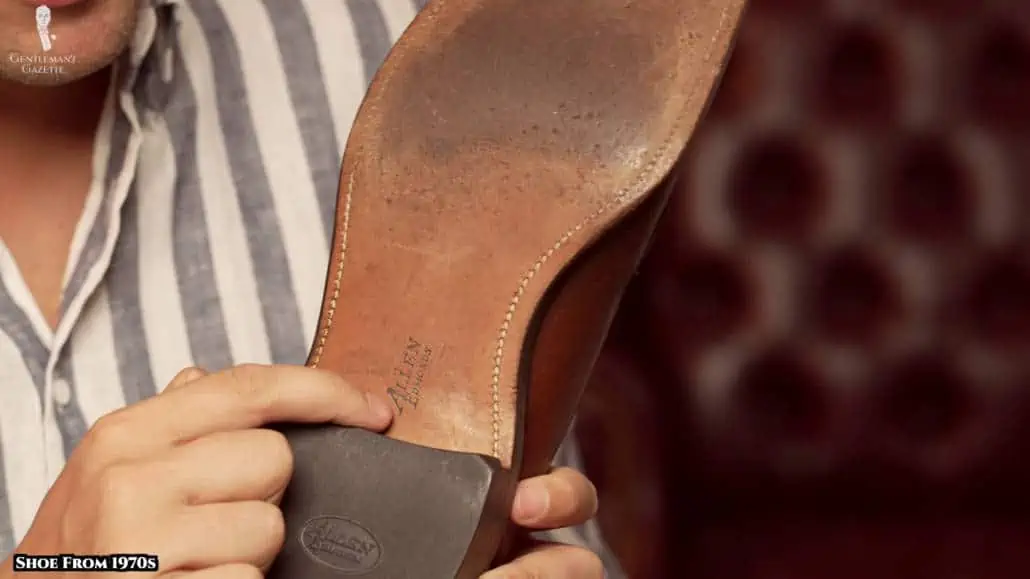
There it is. It has that angle. It seems to have the same construction as the old one. Now, you can see the leather is so brittle that, even on the sole level, it already breaks. But, that’s the same construction that we saw, that this extra kind of triangle piece that they laid in. It looks like a compressed leather of some kind I would guess or maybe it’s just because it’s so old.
Yeah, but look at that. It doesn’t look, doesn’t necessarily seem like top-grain but maybe it’s because it’s all so dry. This does have like a compressed look to it though. Same nails though and different like construction where the outside was built up.
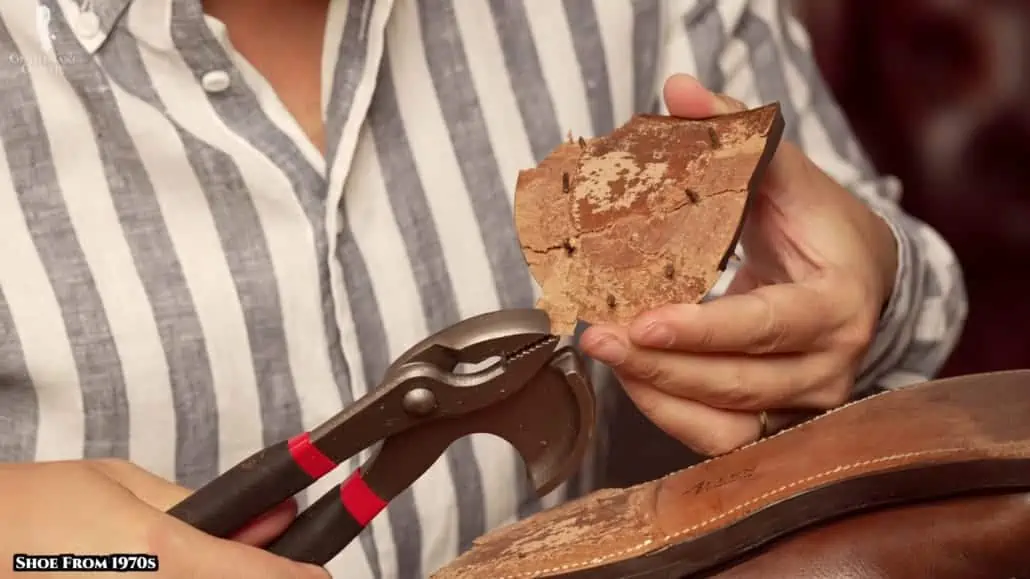
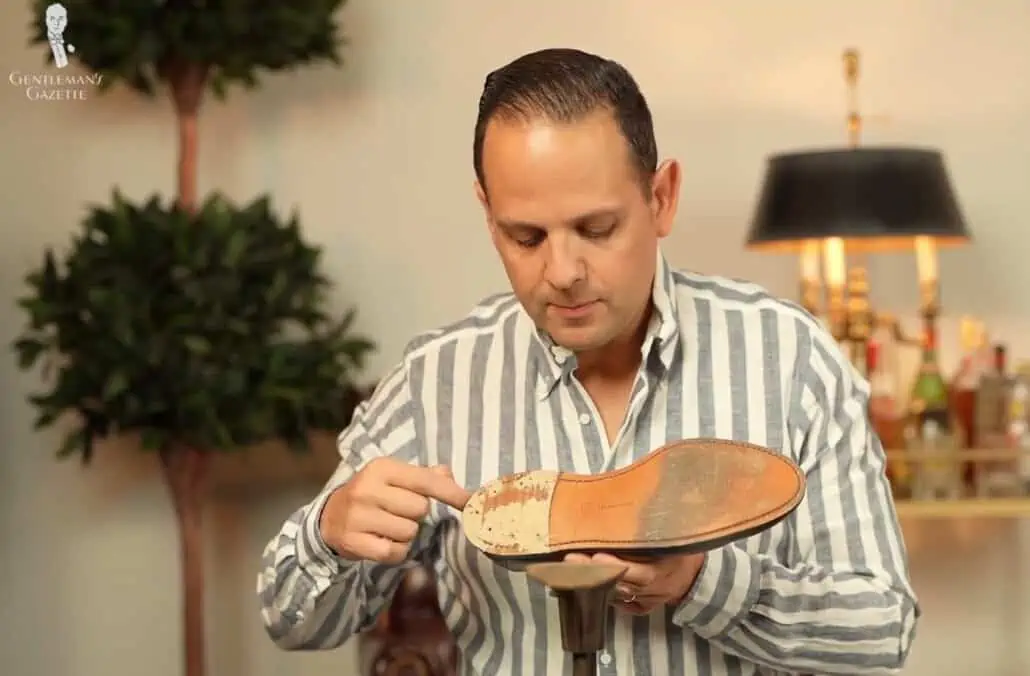
Now, you see the famous 360 welt from Allen Edmonds. They use a Goodyear welt, and they always advertise the 360 welt in recent history. That being said, there’s really no difference in having a welt that goes from here to here or around the heel. There’s no benefit. Typically, a bespoke shoemaker goes from here to here and leaves it off, so they can really tightly pull it up and just the heel looks a lot more elegant.
2. Outsoles & Sole Stitching
2A. Shoe from 2010s
So, next up, let’s go through the sole stitching here and try to cut it open. As you know, as you can see, Allen Edmonds typically has this kind of open channel stitching and so, you can see where the outer sole was welted on.
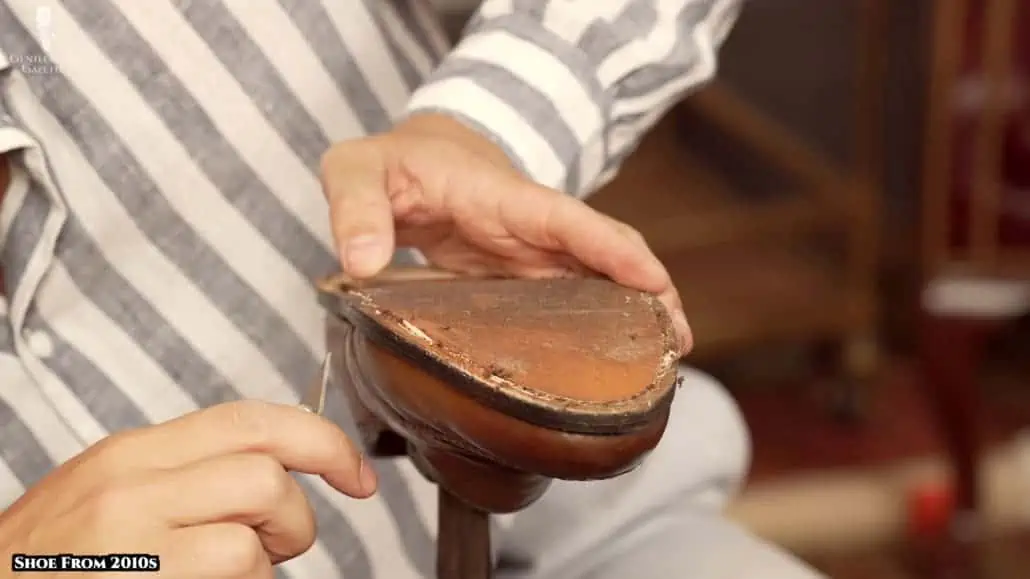
Now, this is not the Goodyear welt. The Goodyear welt is on the inside and we’ll see that part later on. Now, the welt is cut from the bottom and, ideally, now, we want to remove the outer sole. So, basically, the welt is on top here.
The outer sole is here. I’m trying to find the different layers and then, I want to take them apart. Voila! This is the outer leather sole and that’s usually what you walk through. You can see this shoe wasn’t heavily walked on. Nice piece of solid sole leather.
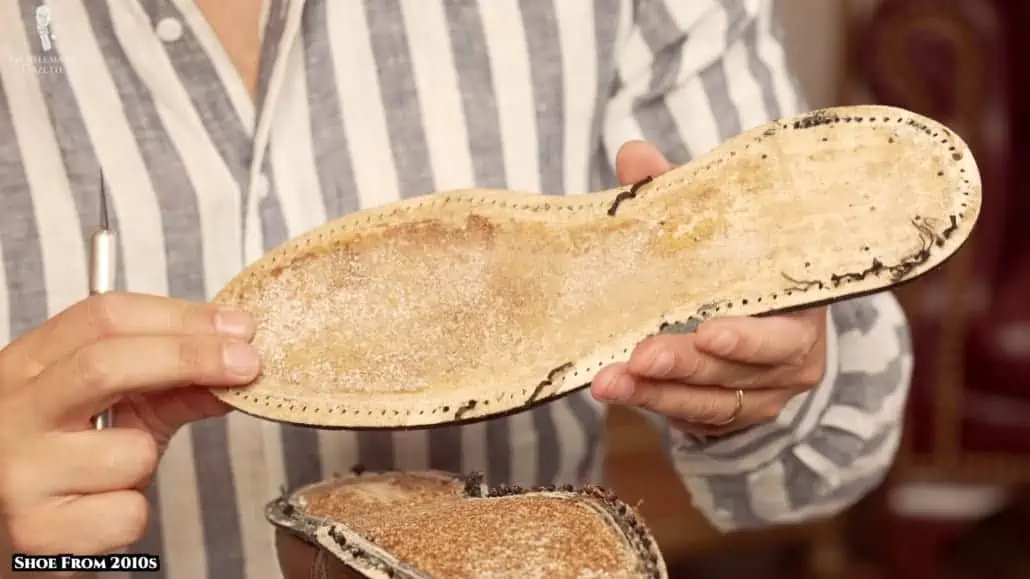
2B. Shoe from 2021
All right! Sole! Outer sole. Different labeling, different branding. But, still, like, stiff sole leather. It’s kind of the outsole here.
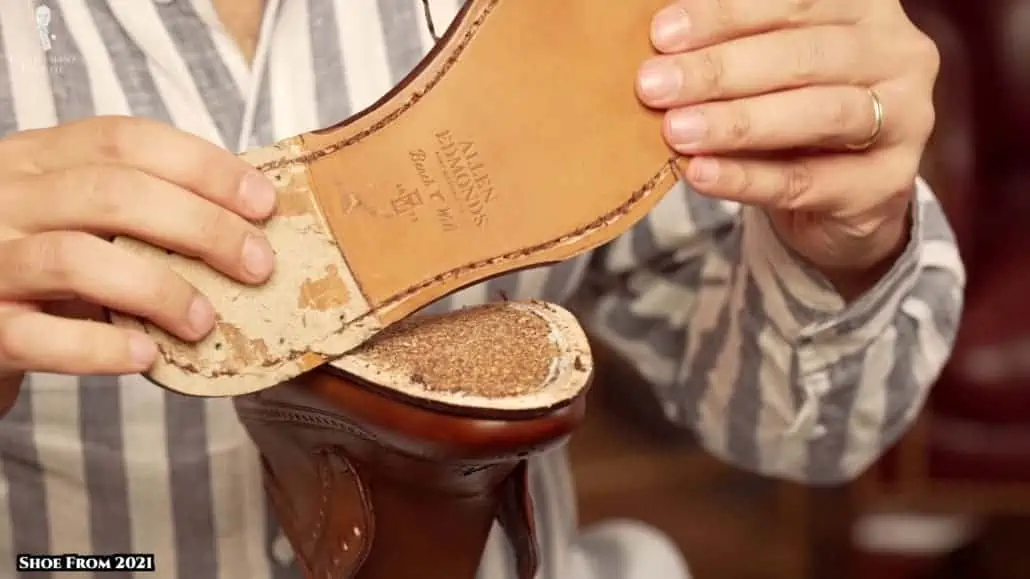
2C. Shoe from the 2000s
Allen Edmonds’ outsole. Very similar to the other one with the same logo. I can’t tell the difference.
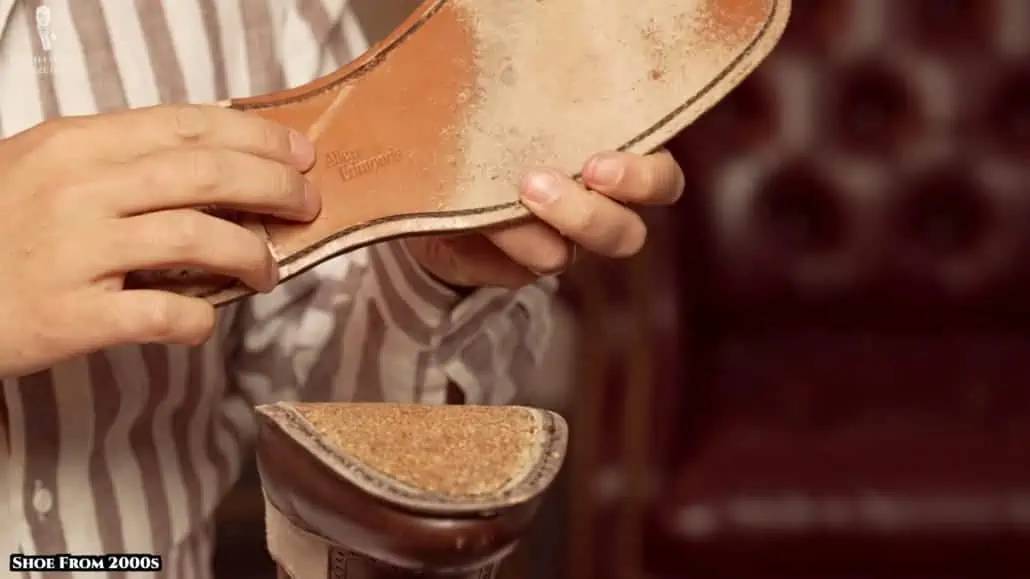
2D. Shoe from the 1970s
All right. So, that was the outer sole. Nice piece of leather. Some kind of glue in there. Yeah, pretty good quality.
And, now, here, we see the Ostendo Cushioned Heel. That’s probably what they meant by that and, at the time, it was probably a novelty. This looks like — not even rubber. Maybe it’s just hardened over the years. I don’t know. It feels like plastic.
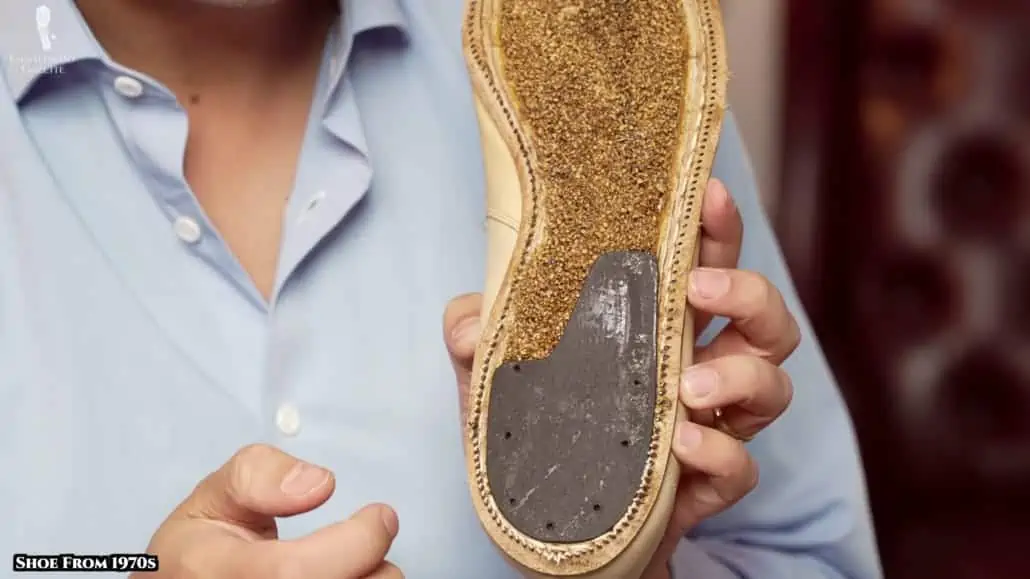
3. Midsoles (Cork, Foam) & Shanks
3A. Shoe from the 2010s
Okay, so you can see the outer sole, thick leather. “Allen Edmonds – damaged.” And then, interestingly, it’s a piece of fabric here. No idea what that is for.
So, the next layer is the midsole. Full leather and, again, our Ostendo friend. So, you can see, it was light so it was a little longer on the outside than the inside.
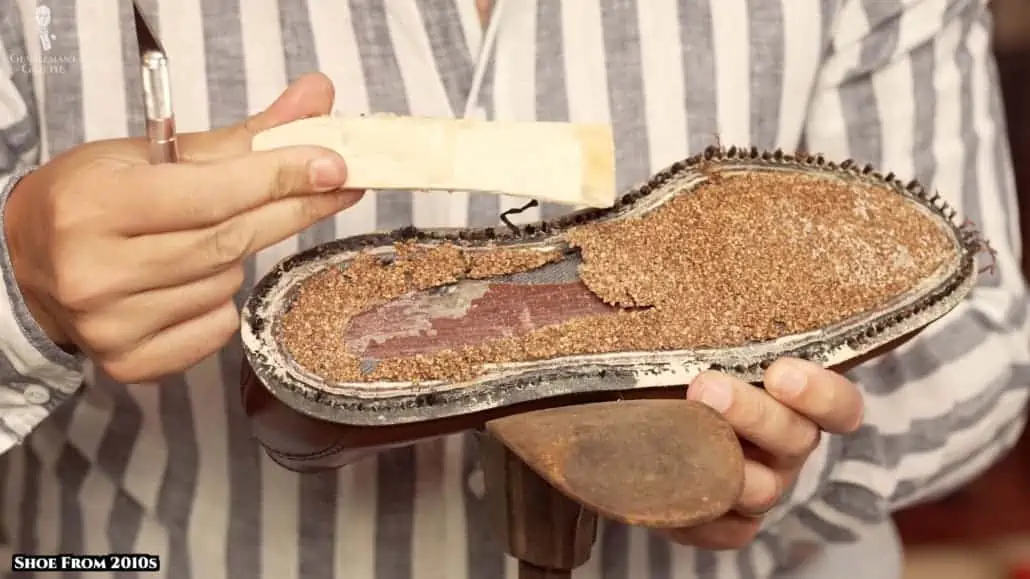
So, now, as you can see here, we have a shank and Allen Edmonds is known for their wooden shank. Some other companies use a composite shank or a metal shank typically. Sometimes, they claim that when you have a metal shank, you know, and you go to the airport – the TSA, it will beep and you have to take off your shoes. With a wooden shank, you don’t have that issue.
It’s a flexible shank, but it breaks, right? So, do you have a chance that, for some reason, you do it too much, it can break. So, I’ll just keep the shank here
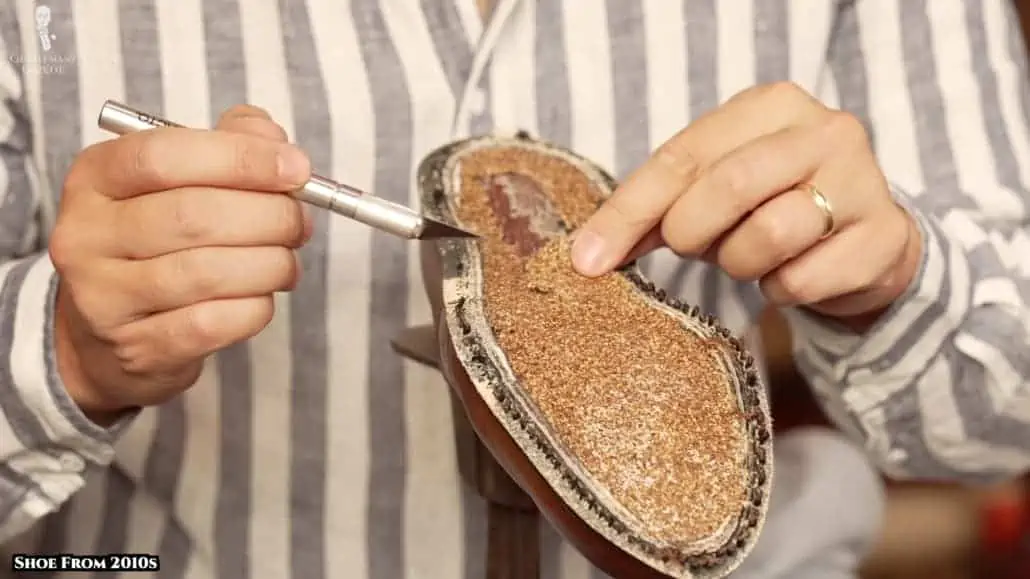
Otherwise, you see here, this is cork. This is not a layer of cork as maybe a custom shoemaker would offer you. This is just typical glue mixed with little cork. And the idea is that your foot will get used to it over time and it will be more comfortable to walk in without being too squishy and soft. This material is pretty typical to what you see in a ready-to-wear Gucci welted shoe, so there’s nothing bad about it. This is very, very typical.
Getting it out here. Over here, you can see there’s a little metal tag here. This one, too. I don’t know why they use those. I would assume it’s to keep things together, maybe in the uppers or anything like tucked in.
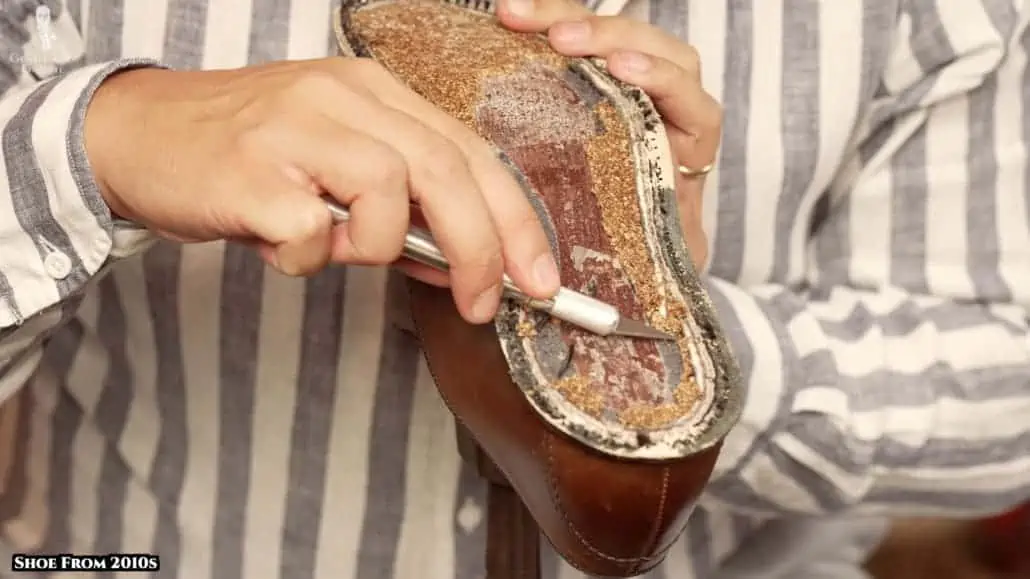
I’ve been to the Allen Edmonds factory and I did not notice these little tacks. Underneath the cork here, you can see another layer here. I don’t know if this is a thermal layer and out here it is the welt and then, in here, these are like the upper leather, the lining leather kind of stuff here, and we’ll see more as we take them apart.
What’re we gonna have? Getting out the insole of the shoe, which is exactly what you stand on here. All right, this is the insole and you can see, from the bottom here, there was the insole. So, underneath, you just had this wooden shank, then the cork, and then the outsole. There was no foam or anything of that kind.
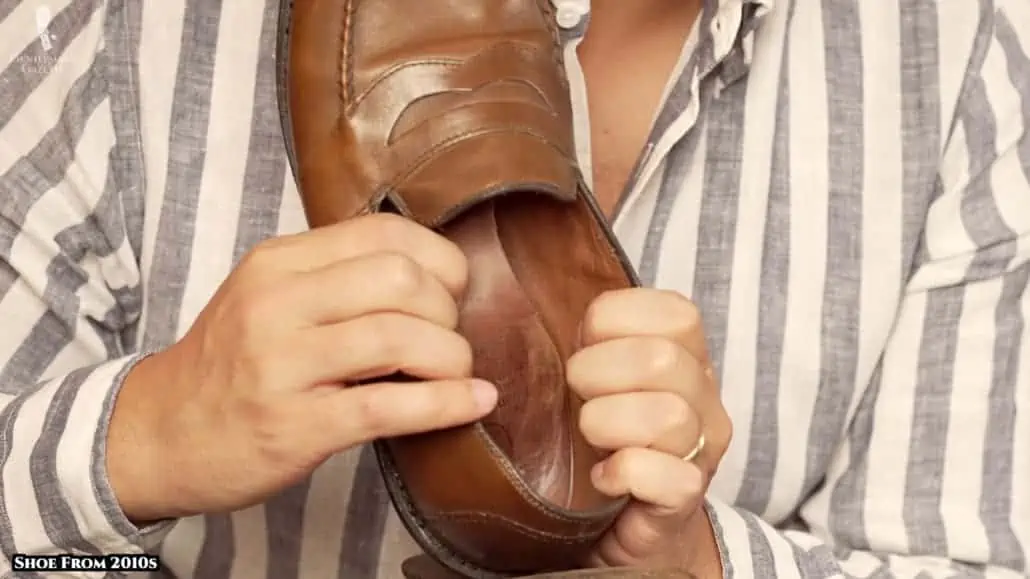
3B. Shoe from 2021
You see the cork mass that we also saw before. Here’s a shank again. Wooden shank, not thermal plastic. It was placed rather far back in the shoe. Typically, you see it more like may be placed here. So, I wonder why it was placed so far back? Maybe an oversight. Maybe it shifted during production.
It’s obviously a new shoe that has never been worn, so the glue is working really well. Same construction as before with the exception of the shank being further back.
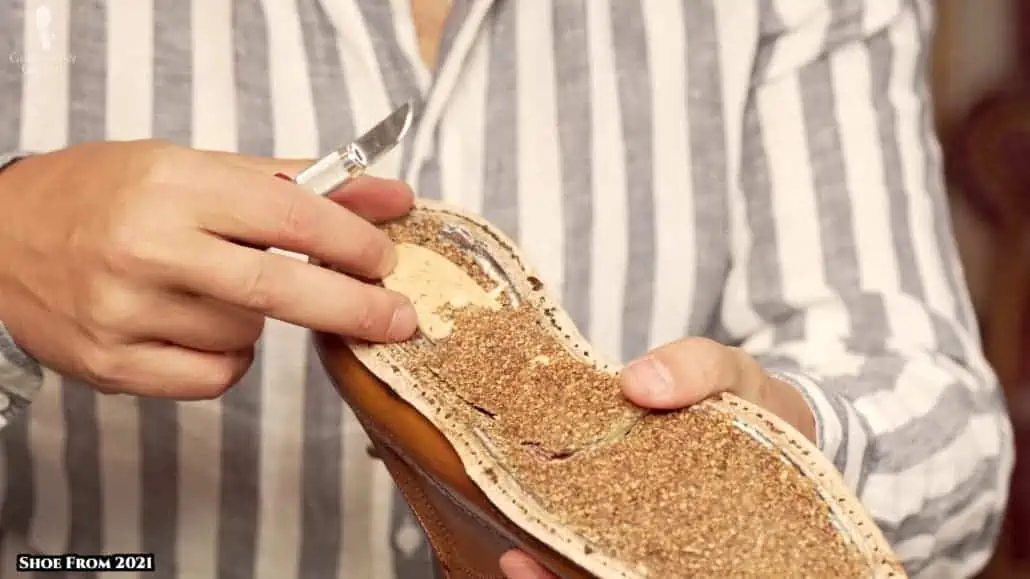
3C. Shoe from the 2000s
Interesting. Apparently, there’s like a layer of something. It’s not a shank, but it’s a stiffer, kind of, almost like a thermal plastic layer. Yeah, I wonder if that’s supposed to be instead of a shank. We’ll see. We’ll see. It’s definitely a slightly different shoe, so you can see Allen Edmonds changed the way they did things over the years.
This is a nice thick cork. Maybe it’s because the shoe hasn’t been worn much and it wasn’t compressed. You’re looking at it here. It’s floppy. It’s not stiff or anything.
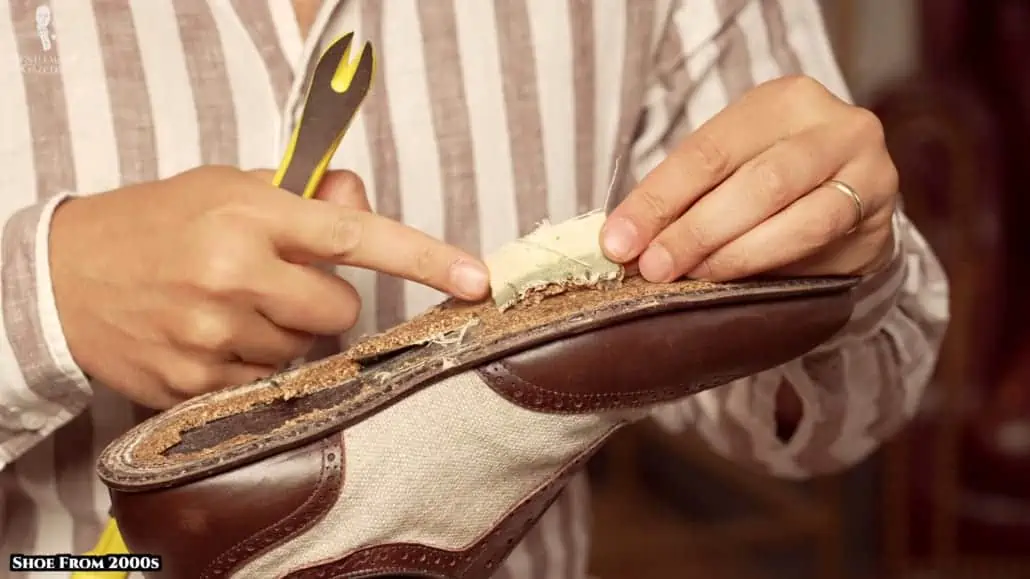
Interesting. You can see a layer of plastic in here. Sometimes, the shoe factories wrap the shoe in plastic so the leather can’t be scuffed, and then, when it’s tacked on, there’s a little layer of plastic film that you can still see here.
3D. Shoe from the 1970s
As you can see, no shank. At least, nothing I can see, for now, just the cork. It’s definitely dry but, you know, you’d expect from a shoe that old. I mean, cork, right? It’s this bark from the tree, so I also don’t know how these were stored over the last 50 years. Yeah, a lot more porous if you compare.
Here’s some of the new stuff. It’s very flexible. Then, here’s the old stuff. It’s just falling apart, but this looks like the insole right underneath.
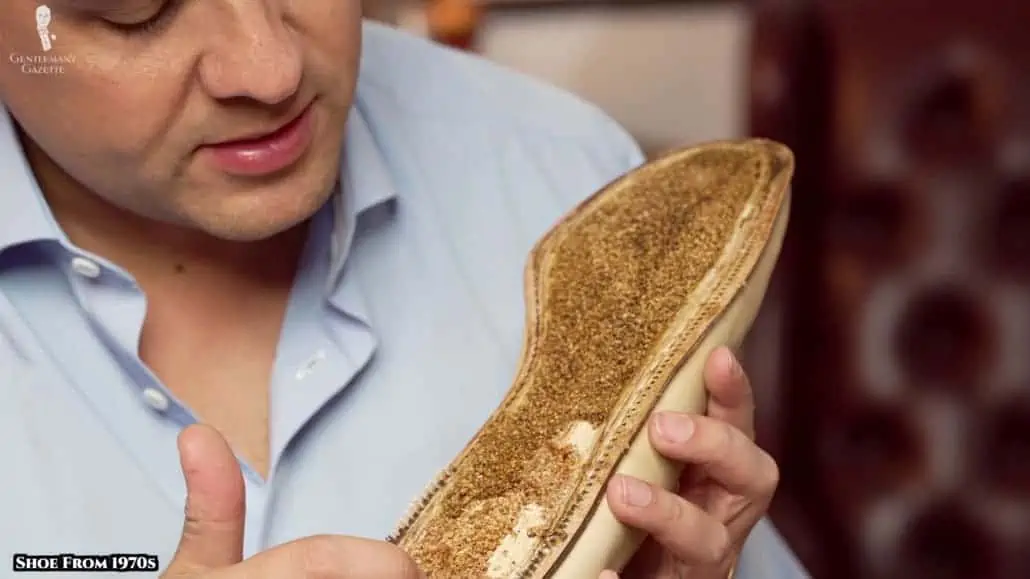
And, look at that, the usual suspects. The little tacks that they used all along are still here. You see a nail here. Now, that’s unusual. That’s the first time we’re seeing a nail.
Before, remember, we saw those little kinds of tacks that were used all along. This is the traditional shoemaker’s way, so I would guess this shoe is the oldest one of the bunch because all the others had the same system, all the way to the latest one we just opened. Again, there doesn’t seem to be any shank, part of their flex promise.
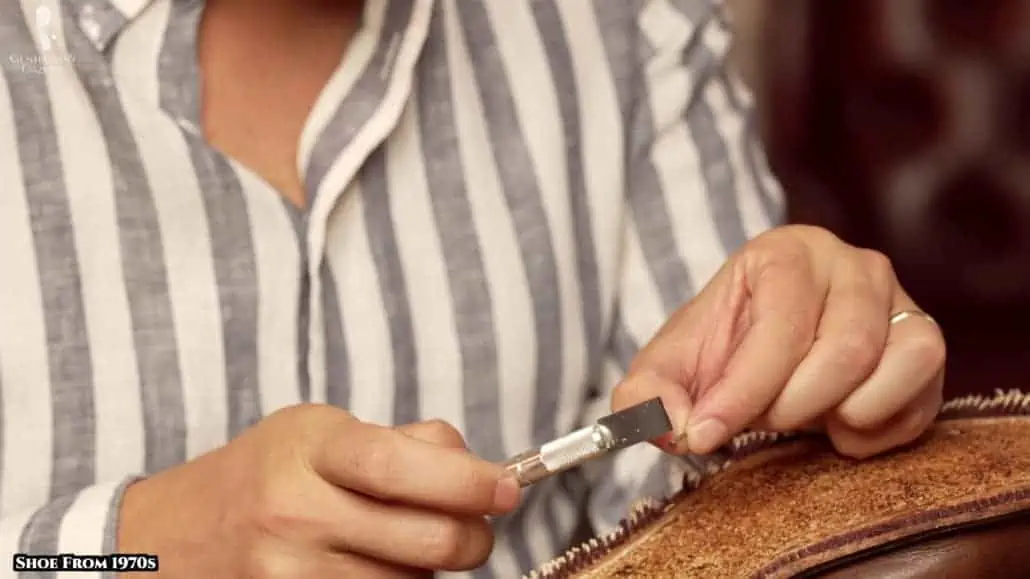
4. Insoles and Linings
4A. Shoe from the 2010s
You see, on the welt here, it’s disconnected here because the welt is actually a long strip that is then bent, formed into shape, and it’s open. It’s not stamped or cut out from a single piece of leather. This is the welt strip. You can see it.
So, you see this is not aniline-dyed leather but, in fact, the top brown is a lot lighter than what’s underneath. Now, aniline-dyed leather is generally a very good leather. Top-coated leather can be good, but the majority of cheap leather is always top-coat colored, not aniline-dyed. When aniline-dyed, chances are it is of high quality. So, it’s a good indicator but it’s not like absolute truth.
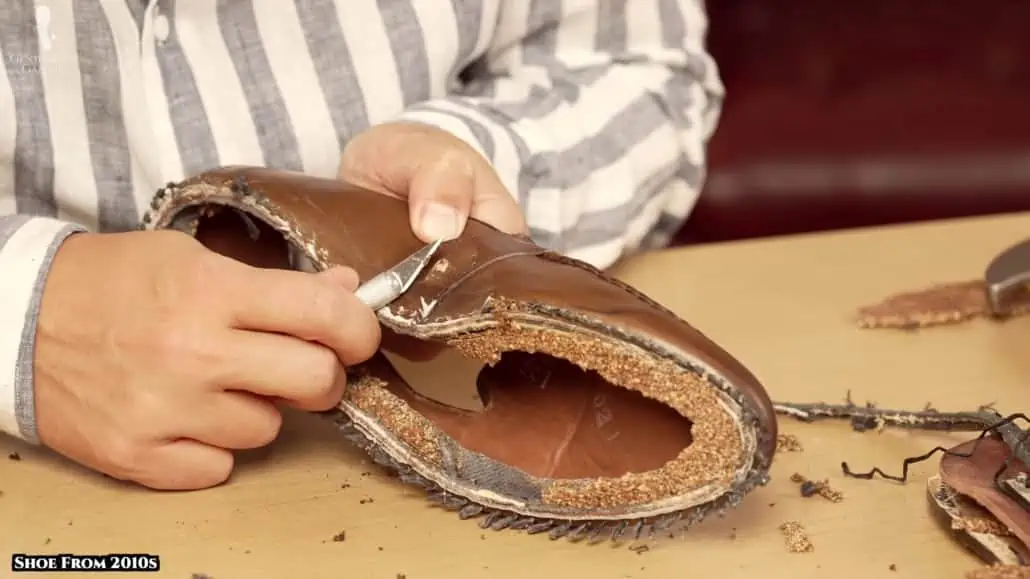
Metal tacks here that keep the uppers together so, probably, they don’t shift when the shoe is sewn together or the uppers are sewn together.
You see here, there’s like a lining material underneath the penny loafer part and you can also see that the leather was burnished after it was sewn together. You can see here, from the outside, it looked like it was one piece of leather but, in fact, they have seams here and they do that to just save on the cost of leather. If you have smaller pieces, you can get more yield out of any given skin. You can also more easily cut around defects.
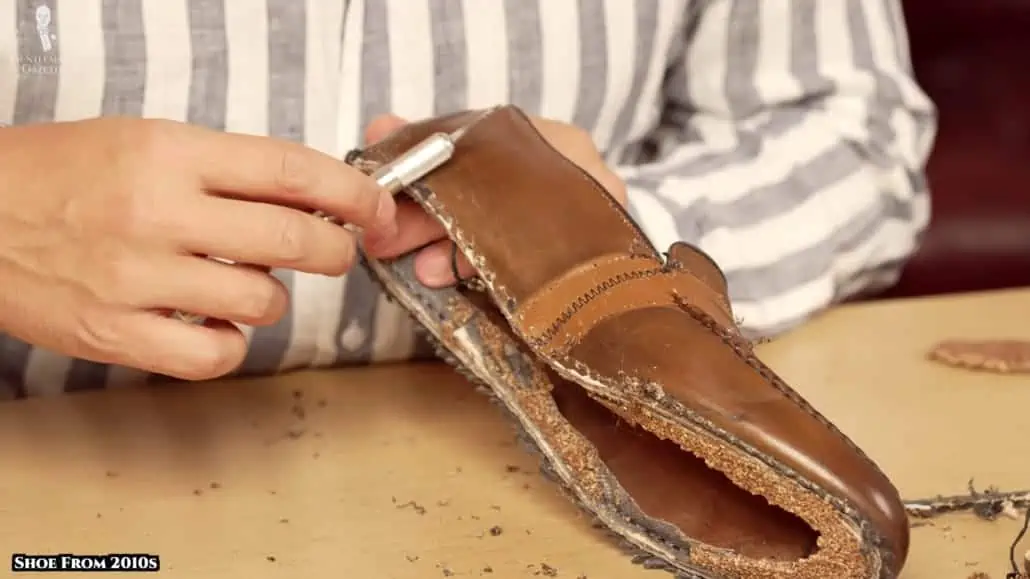
The lining, which seems to be leather, and it’s attached to the outer layer, which has an additional lining layer. The same lining that we found underneath the loafer bridge there. Now, as we come to the back here, you see something white and this is a thermal or thermoplastic cap.
The heel cap is supposed to keep the heel stiff, so the shoe lasts for a longer time. It gives you stability when you walk. Traditionally, you know, if you go to a custom shoemaker, this is all leather. A very stiff leather is shaped. After, it’s wetted.
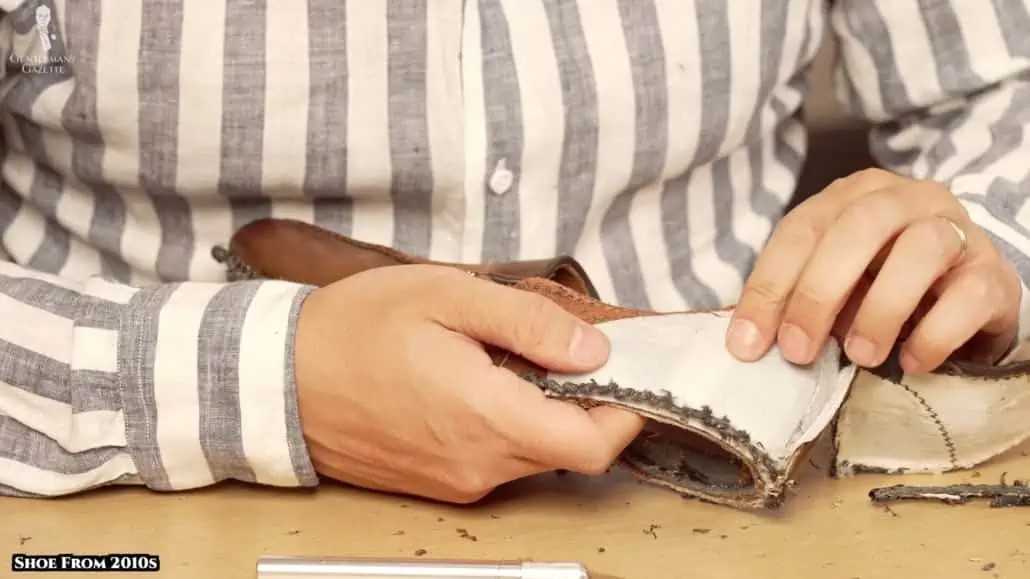
Looking at the stitches, you can see there’s a different stitch density here than it is here. It gets a little wider, so I would guess this was done by hand because of the inconsistent stitching. So, it seems like it was one piece of leather and I just pinched it together.
As you can see here, it says “handcrafted in the USA.” This is the top piece. They added another layer of interlining.
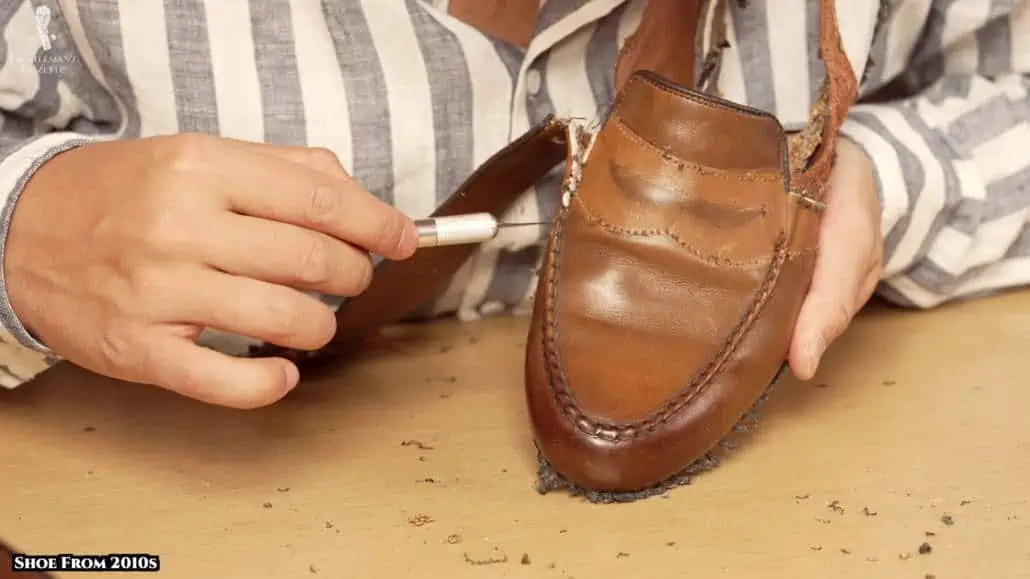
See, over here, the piece on top is continuous. The pieces underneath are not. This white cloth interlining in the back and then some black underneath and that was, of course, the thermal cap, which is still on this side. It’s between the outer layer and the lining. You see that there’s just the layers that all come together and then this leather is sewn on top so it’s nicely piped. Got a smooth edge on top. Nice level of workmanship.
This thread seems like a waxed thread, which is typically what you see when shoemakers use stuff. You can see here, this is one piece of leather and they just put a liner up to here, which gives it a little more fullness and they tie it together tightly from underneath. So, yeah, this is good quality. You know, well done. Just like a shoemaker would do it.
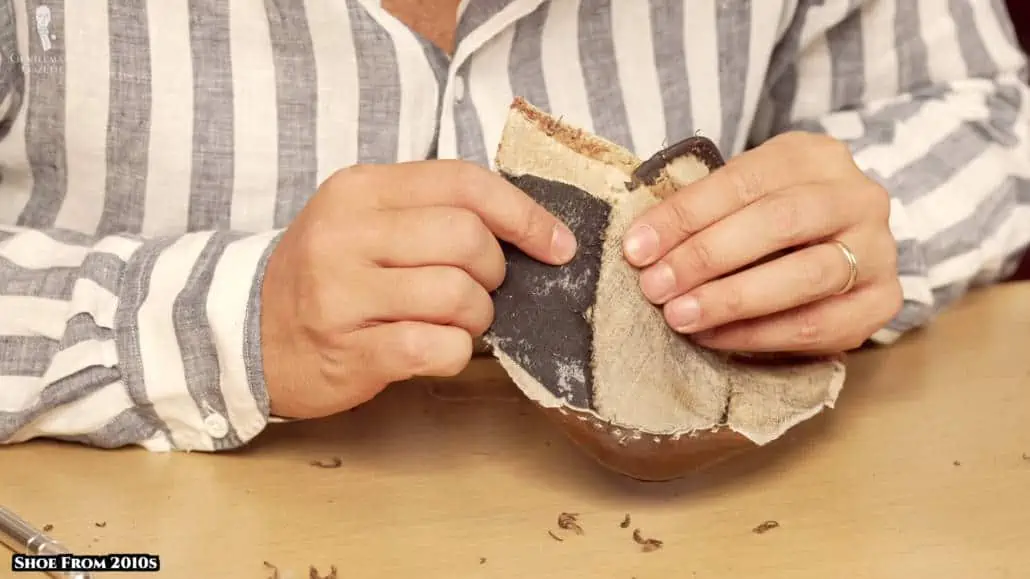
You see all these metal tags in here. They’re all over the place. Okay. So, you can see, again, there’s this kind of fabric liner all over the place, between the lining leather and the uppers. Seems to be like a nice lining liner by the way. It’s soft. It’s definitely dyed. So, I wonder if it would color off if you had like white socks, for example.
Then you have that thermal cap again, just like you had in the heel, and then underneath, there’s really just, it’s just glued on onto the leather. There’s nothing else there.
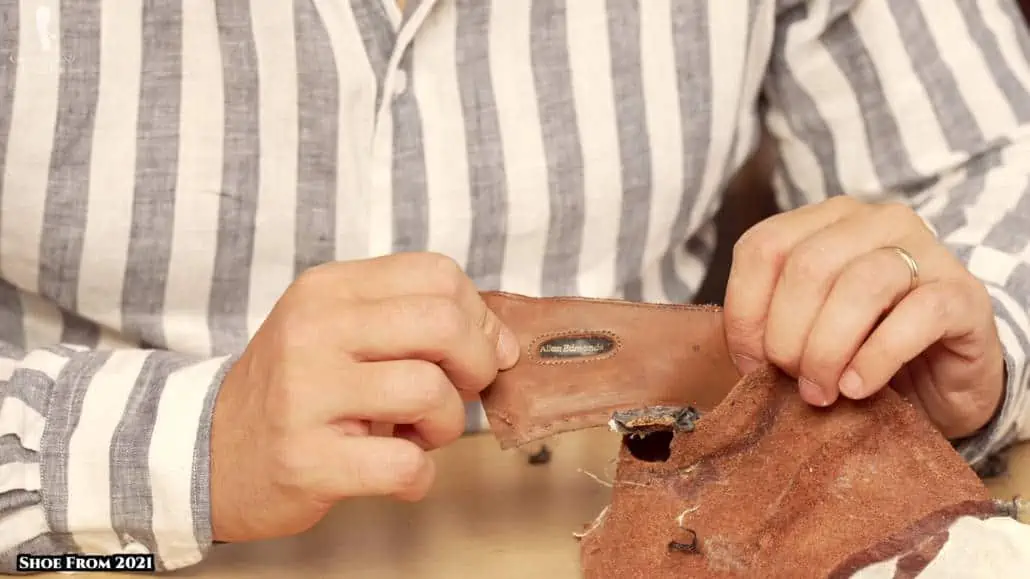
The seam just comes here on the side, versus on the outside, the seam was here in the back. So, it’s just shifted, so it’s not on top of each other because if it was, it would create the leather to bunch up in that area and move it around, but preventing that from happening.
You can see here they sew in the Allen Edmonds sticker from the back. So, you could see it on the inside.
4B. Shoe from 2021
There, you can see like before, leather underneath almost like crust leather and nicely burnished and finished and colored on top. We see the same kind of construction and the same thread color as before. You can even see all the tags.
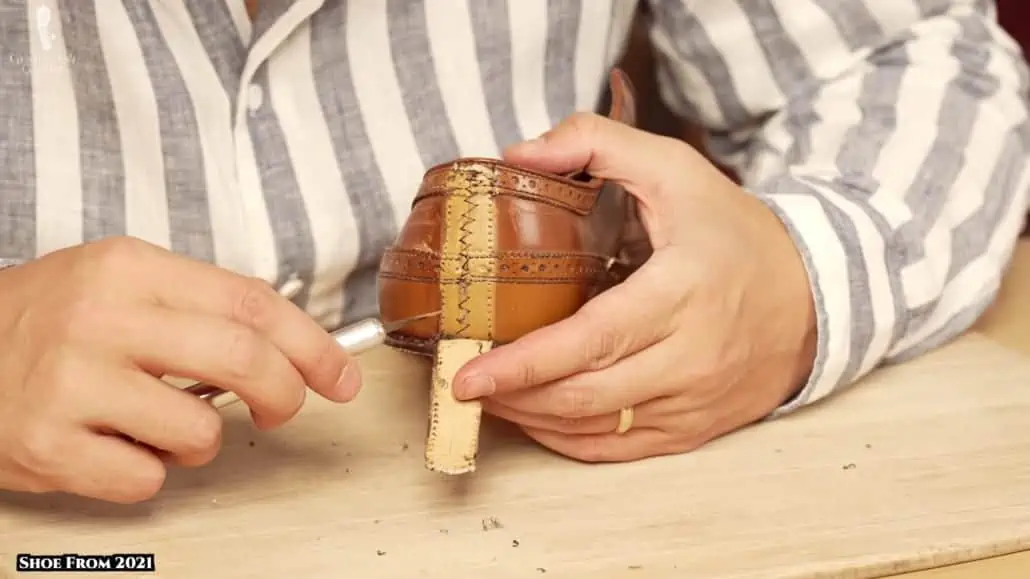
Same procedure here, 360 welt all around, a slightly different color but still one piece of leather. Same construction, right? This is the gem band and it’s like glued on to here. In a custom or bespoke shoe, you’d have this insole to work out a channel and then a gem band. There’s no gem band, but it’s connected by sewing it; it’s not just glued.
Alright, here is the insole from the bottom, and now they have an insole lining. They say “Custom Cork Insole. Handcrafted in America from Import Materials.” It’s the style Grandview.
So, this is basically a lining leather material insole. It’s backed by a lining and a little foam pad is added for comfort. Eventually, the foam will kind of wear out and lose its cushiness.
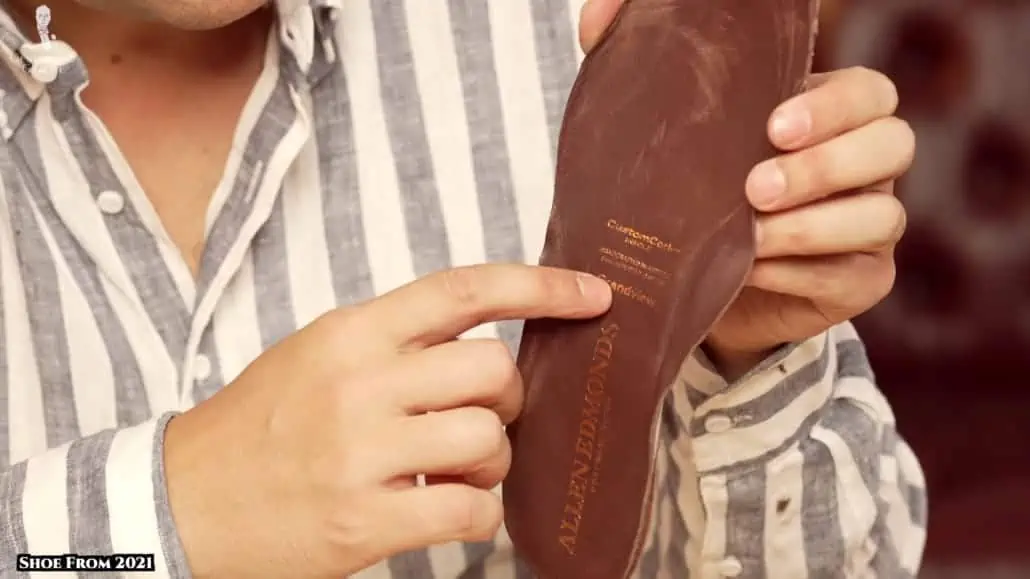
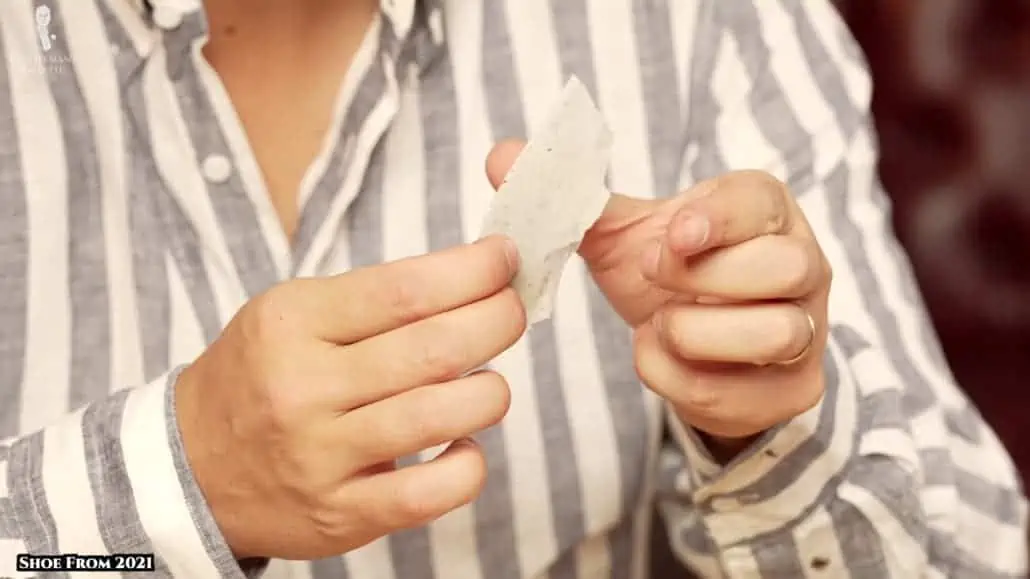
This insole, on the other hand, is leather. It’s not a different material and it looks very similar to the insole that was in the other Allen Edmonds shoe that you would directly stand on. Here it’s not as neatly finished. It’s the same lining material that you had here. It feels very similar to what we had before.
Okay, full brogue upper here. See all the tags, just like in the old shoes. Broguing holes are backed by a fabric sewed in, so they look kind of dark from the top.
Now, here you see that fabric backing all across the bottom here. All the sewing here creates a little bulging and then nice piping on top. So, it looks good.
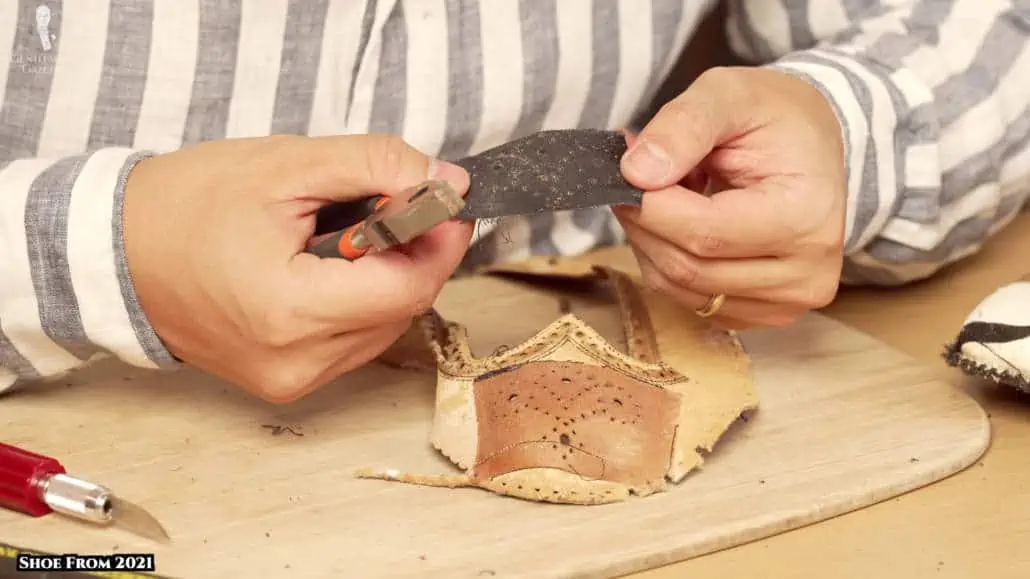
You can see the upper here for the wingtip, slightly kind of taped reinforcement here, so the leather doesn’t rip in the areas where it’s, there’s demand for support. Fabric backing – another kind of layer here in the back, and then the thermoplastic cap.
Otherwise, the leather lining is very, very similar. If not identical lining. Just different here, cut differently because of the model and sewn together differently.
The leather seems to be of decent quality. I don’t see any issue with it. Exact same texture on the old shoes and thermal cap with the familiar cloth lining on top.
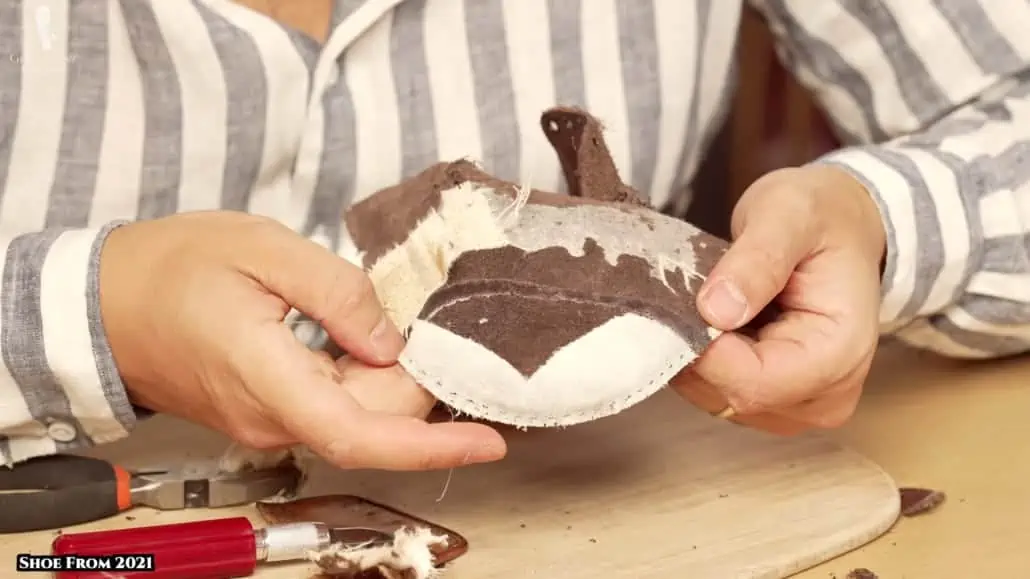
Otherwise, same here, slight reinforcements here: the toe area, glue, and the leather lining. New label, new marketing, but construction, pretty much identical. The only difference really is that you don’t just stand on this anymore, but you have a little bit of a foam pad under the heel, and then another layer of lining on there, which I don’t think is bad at all per se. Makes the shoe maybe a tiny bit smaller and tighter, but if they adjust last, I don’t see why not.
4C. Shoe from 2000s
Here’s you see it’s nailed still from the inside and, uh, I want to take those at first, so don’t hurt myself. So, insoles are here and insole liner, and underneath that is a layer of white foam, just so it’s softer to walk on it, but underneath that is actually an insole made out of a material, which in Germany, it’s called Lifa. It’s like a leather fiber material that’s what you find in like, you know, 99% of all like cheap shoes. That’s the kind of stuff you see there.
Interestingly, you also see this, uh, metal shank, which, you know, typically, Allen Edmonds has the wooden shank. So, that makes even wonder if they make it in the same factory, and if so, if they just do it for the loafers.
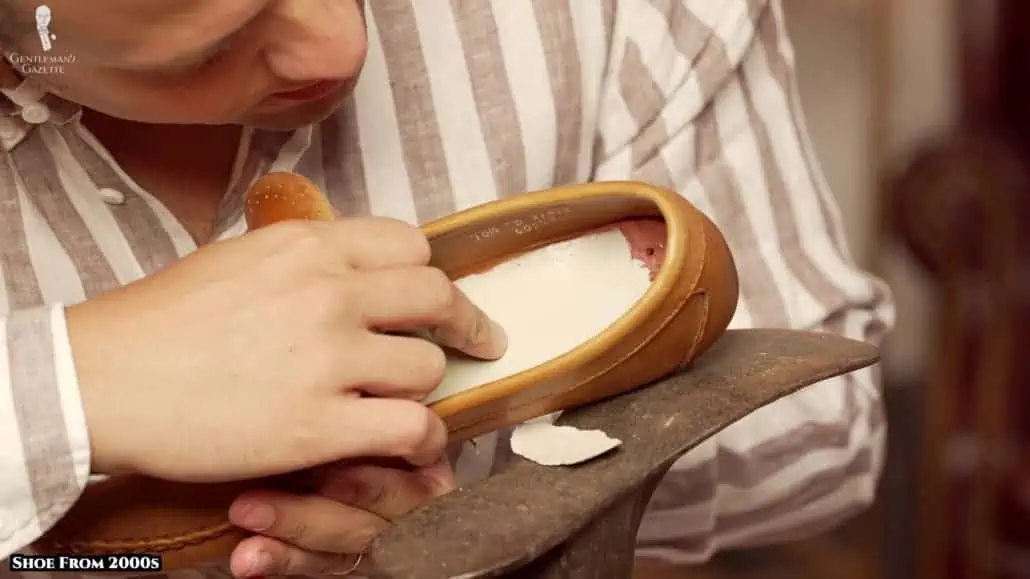
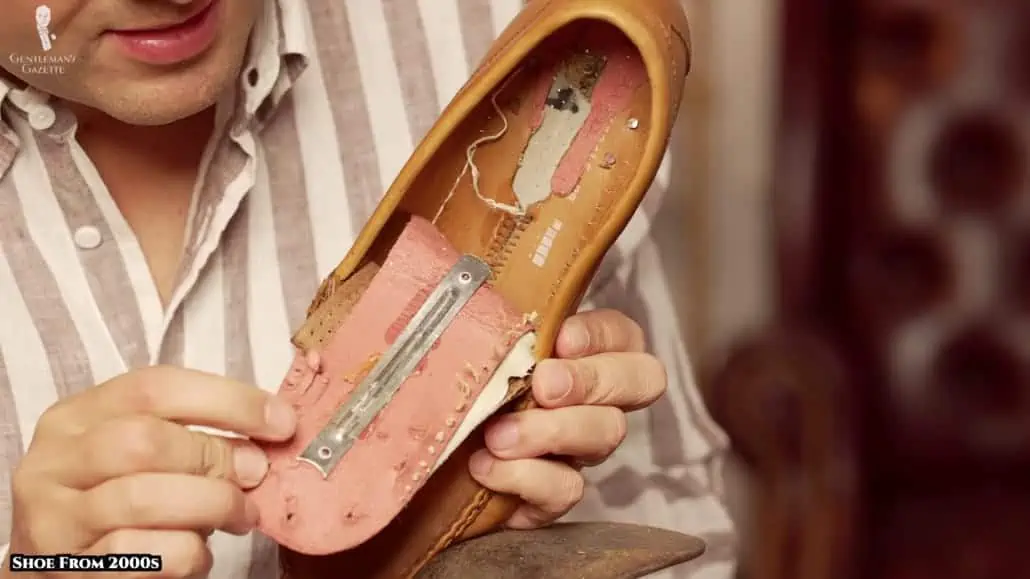
When we saw the other loafer, that wasn’t the case there, but in here, you can see all the nails and they pretty much look like the other ones that we saw. Okay, so the insole liner was on top of this partial leather fiber insole foam. The shank is attached with two little rivets. I’ve seen that before in shoes. Sometimes, that’s the way it’s done. So, here is the shank, little rivets.
Here’s this crappy kind of insole. Yeah, you can see it’s not high-quality material. Now, on the inside of the shoe here, you see it’s like moc-style sewn together all the way underneath here, and then connected here, and then at the bottom they added in another layer of foam that left a hole here for a shank as well to get the foam through. You can see it folded over on top to get it a little more glued down.
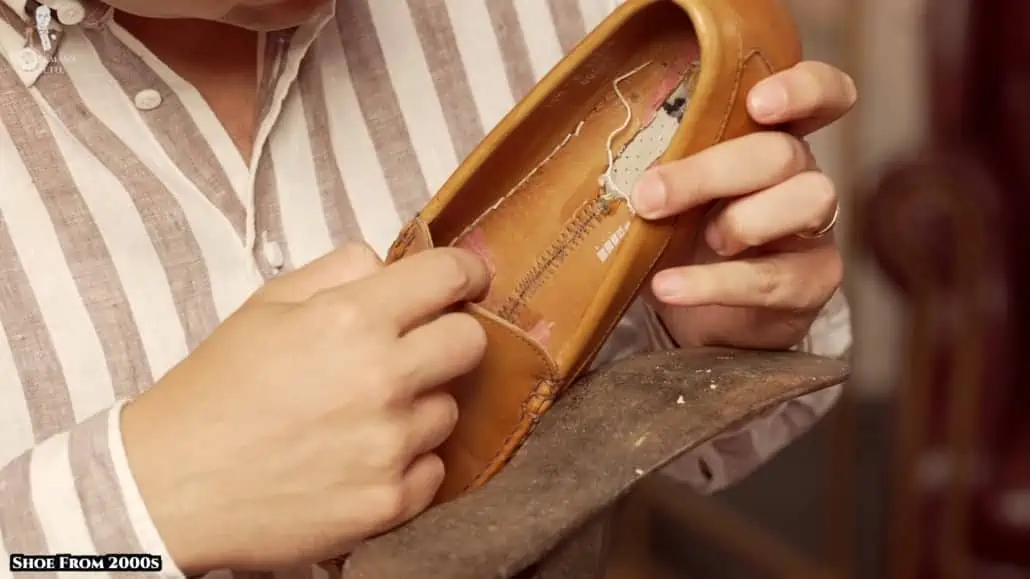
So, that’s the back heel cap. That seems less durable. Honestly, this seems more like cardboard even though it may be another kind of leather fiber, but definitely more lower quality material here in the heel cap.
Trim on top just like lined with this kind of thin, black liner. You can really see the outer leather layer and there’s another layer here in between, maybe just because it’s in the heel, to get a little more structure. But overall, it’s a softer shoe.
The cap is softer, so they used a much softer material there. So, it’s another lining that you would see.
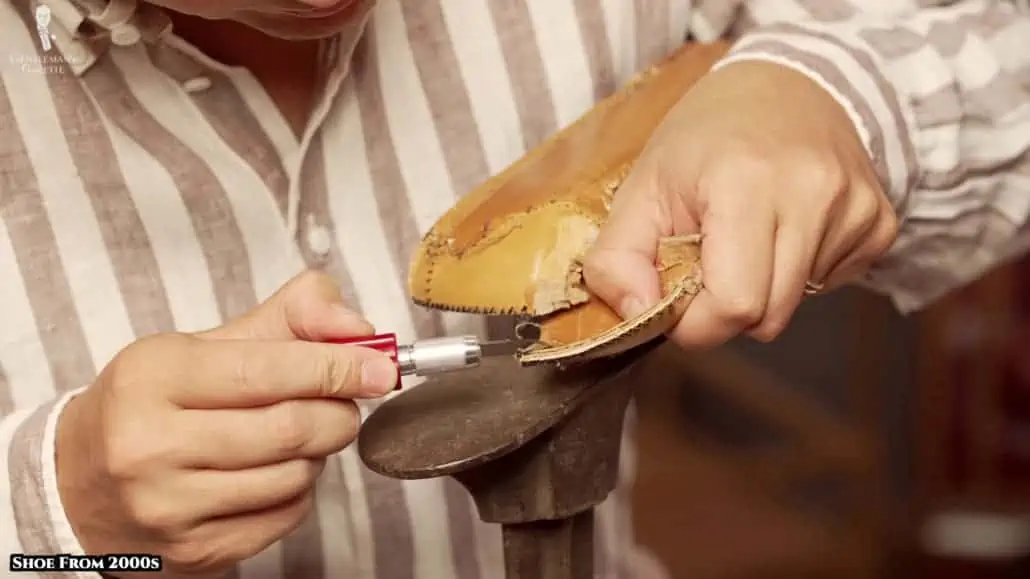
There’s basically this layer of glue, it almost looks like glue tape. I can’t peel that off. It’s directly glued onto the outer layer. That’s a very different alignment than what you usually see. I don’t think it’s age-based. I also think it’s partially based on this moccasin style. So, glad we opened up this one because it’s quite different.
Here, that seems to be the insole. As you see, no shank quite yet. As you can see here, leather heels are sewn together in the middle here. These are the back pieces here.
You can see the tape at the edges with the same material that we’ve seen before, just to reinforce it.
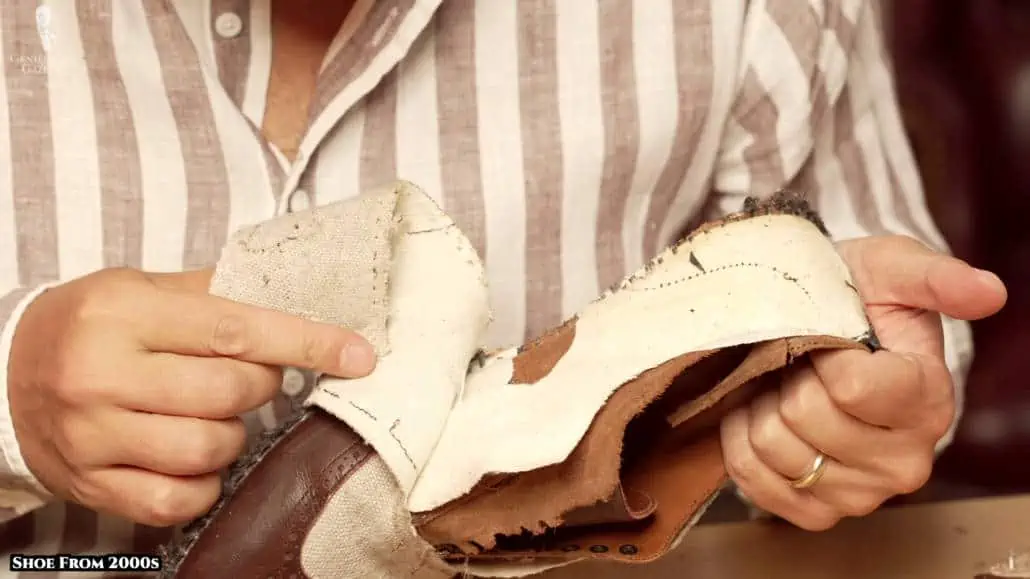
You can see here another underlayer underneath the fabric, which is already backed. You can see the texture – it’s different here. There’s this fabric that is backed here and then something softer is added underneath.
And then, we have the thermoplastic heel caps again. So you can see these are the uppers. It’s definitely glued on; leather was glued into the fabric, so nothing shifts. Down here you see all these tacks again.
As you can see here, a reinforced black fabric layer on leather is glued to this muslin piece, which is backed by another layer. Exactly the same construction as what we’ve seen before. Cut leather, black backing reinforced, then piping on top and lining on the inside.
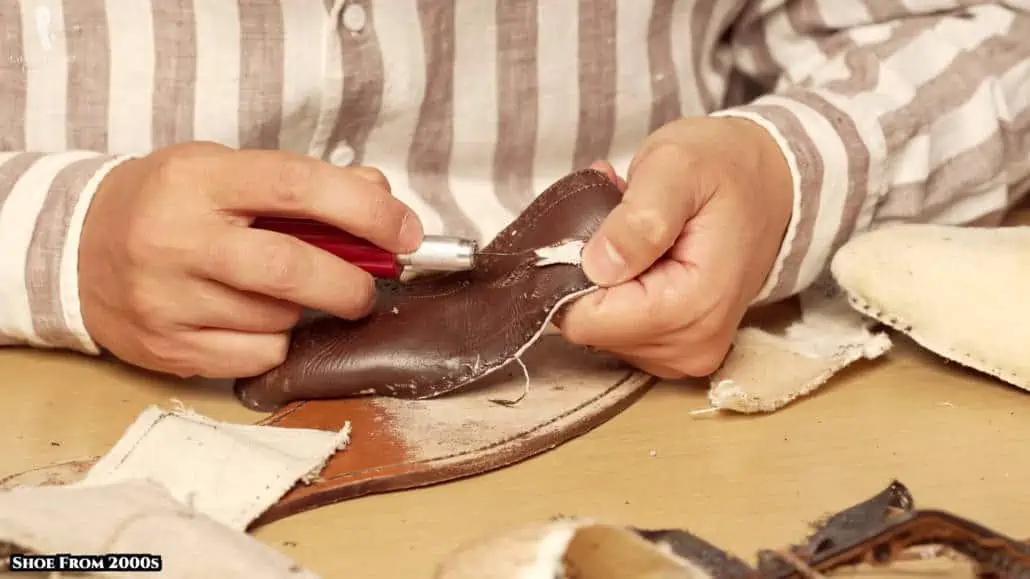
So, leather-wise, if you look at the leather here, you can really see the white coming through. Definitely scuffs up more easily. You can see there’s a finer backing, relatively thin. This is kind of like, I don’t know, almost like a softish linen. I know it’s cotton – nice material for spectators I think. Just like before, typical leather uppers are packed with a lining.
And this here is the insole. Looks quite a bit darker, looks like they put a piece of fabric on there again. You can see this is the sole, just a little piece of fabric.
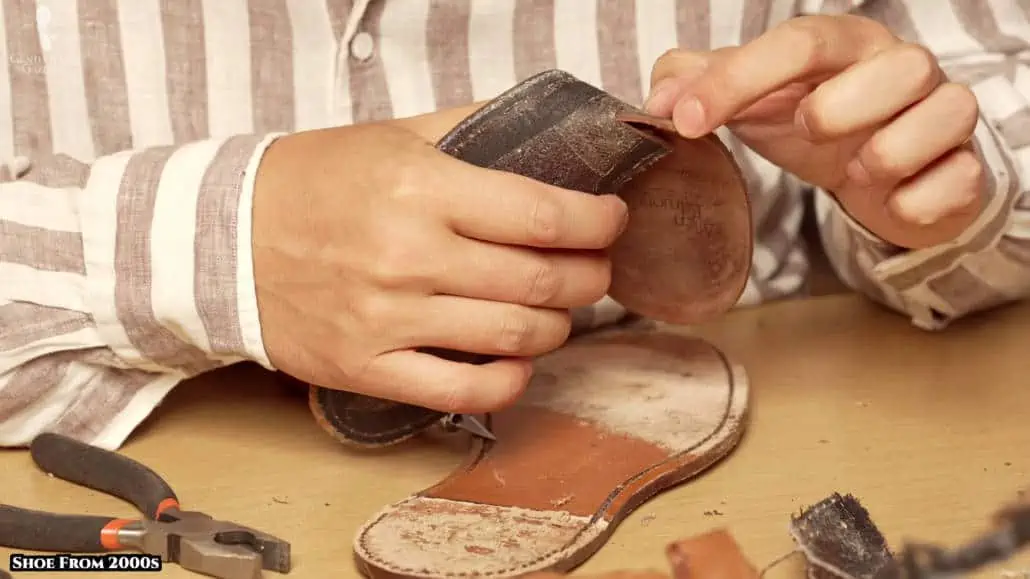
There’s no shank in there. Apart from that, very similar to the loafer that was non-moccasin and Goodyear welted, and the modern Port Washington Allen Edmonds.
4D. Shoe from 1970s
Top part, folded edges with an interlining of all leather. Interesting. Solid leather, I mean, well-done stuff. So, this was the tongue on top, just folded and then glued, skived beforehand, so it doesn’t, so it looks neat and flat from the front. You can see it’s like the stitching kind of slight irregularities, but that’s, that’s cool.
It’s just a handmade, handmade product. It’s interesting that they made this, this cut and overlaid it with this part. I wonder why they did it. Maybe to take out material, so it doesn’t stretch. I don’t know.
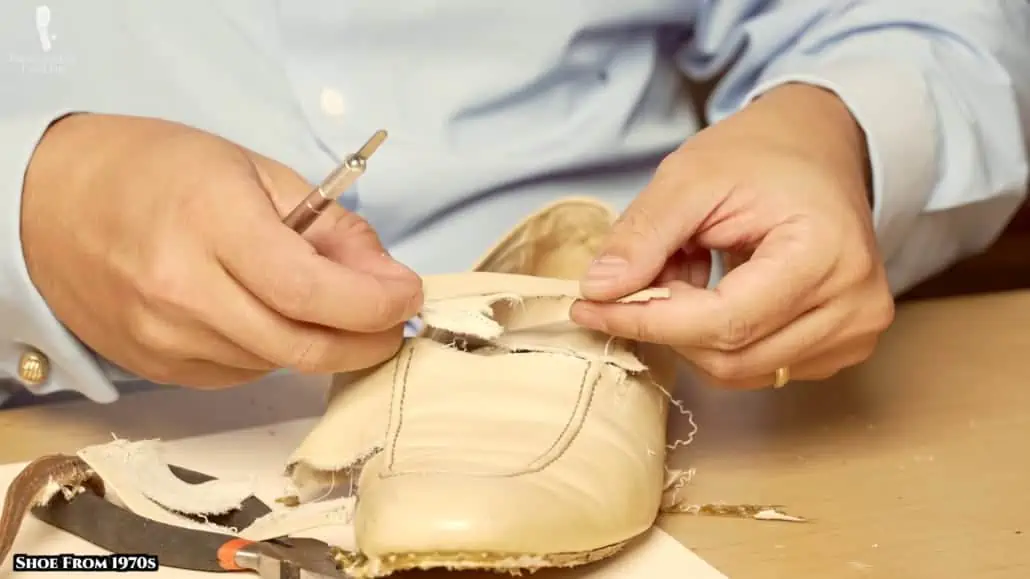
And here we see, probably the biggest difference to modern-day Allen Edmonds. The biggest difference is no thermoplastics. So, you had a layer of leather, then some form of tape that was applied to the leather. No, that’s just at the edges. This is a kind of fabric material with an adhesive backing that was added, and you had it again from the other side.
So, two layers of some form of fabric material, and then, a heel cap made of what seems to be leather is quite cool. Wow!
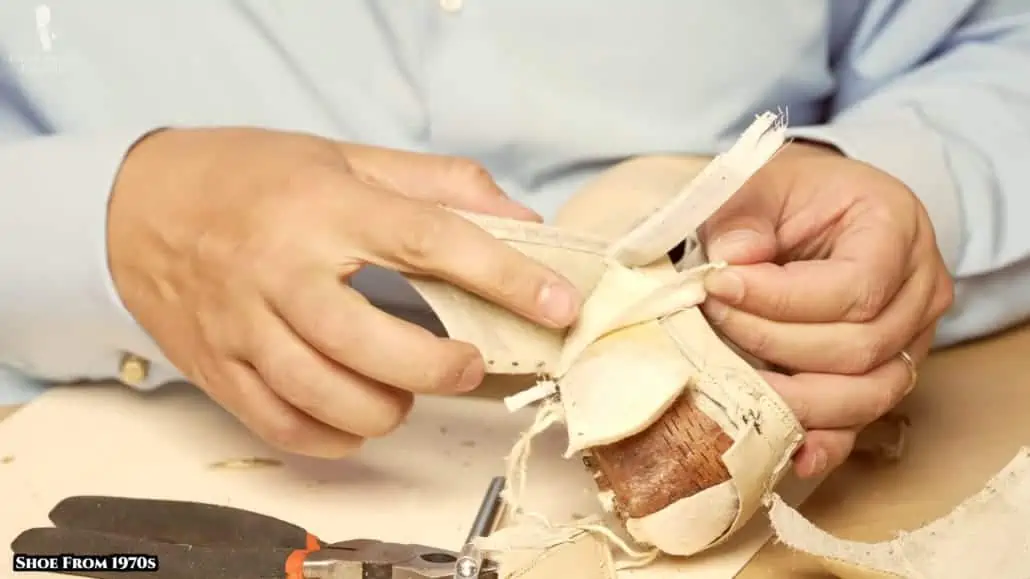
If you look inside of here and cut, you can see there are individual fiber strands attached to it. I wonder how they, maybe they stretch the fibers, then put the leather around it and let it go back. This was definitely a more difficult thing to do.
Oh, I see how it’s falling apart here, but this was a heel cap. Seems to be a leather product, pretty stiff. I wonder if they did this or if they bought the piece like that. It’s just like 3L. So, I’m not sure what exactly happened there.
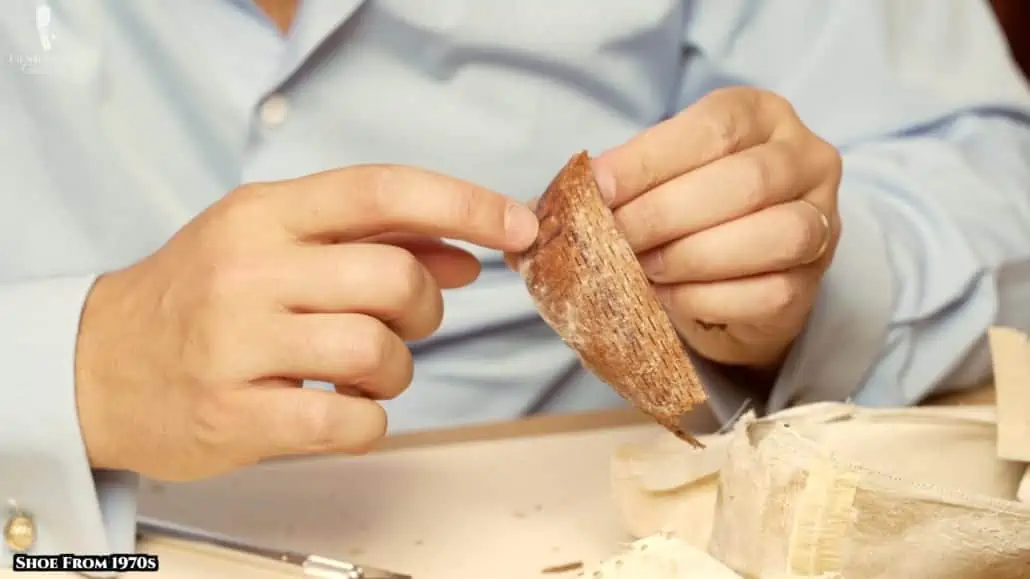
So, this top part, similar to the other moccasins, they have had this kind of stitching here that was just decorative, and this all comes out one piece. Kind of mock-toe, just making it look neat.
Leather quality, I mean it seems very nice leather, even after all these years. The touch is pretty nice. It definitely, you know, has this top coating.
If I scrape up the top coat here, you can see underneath this is kind of whitish leather. Otherwise, it doesn’t look like it’s sanded. It’s still looking good after 50 years, can’t complain about that. There’s just one layer of leather pretty thick than these fabric interlinings. You can see all those metal tags on the side here.
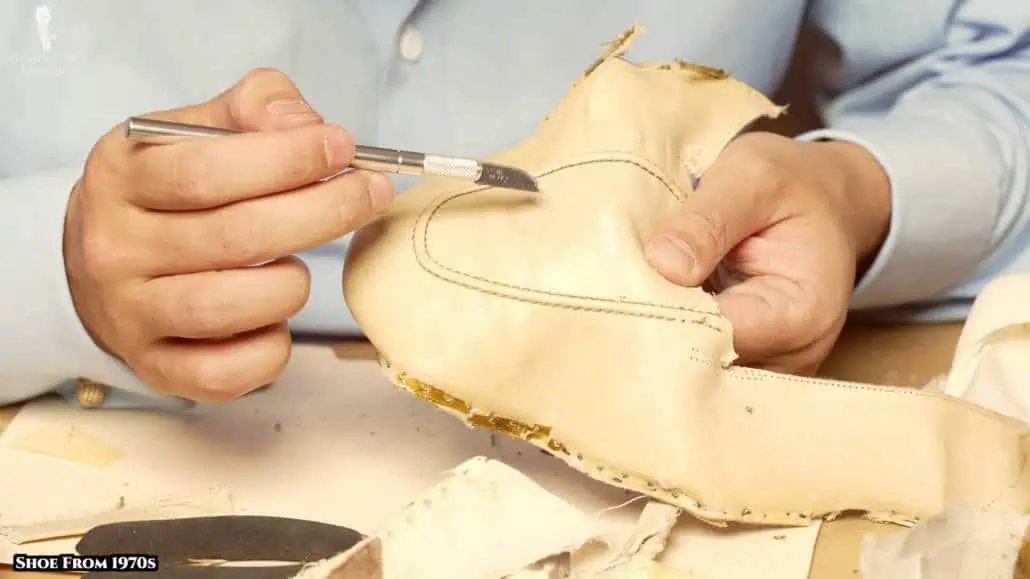
5. Welt Stitching, Gem Bands, Interlinings, Caps & Upper Leathers
As you can see here, this is the gem band that was, again, glued onto the insole, so the 360 welt could happen. One nice piece of leather. Biscayne Allen Edmonds Ostendo cushioned heel. Where is it? Here it is.
That interesting front cap is not leather. Some form of starched fabric, it seems. Leather lining and this is just another layer of fabric. You can even see, this feels like a linen, so the front was linen-lined, which is not something that’s done today anymore, but I have some old Church’s shoes, where they did it as well. I find it quite comfortable. So, the back was leather-lined, and the front was linen-lined. Pretty cool!
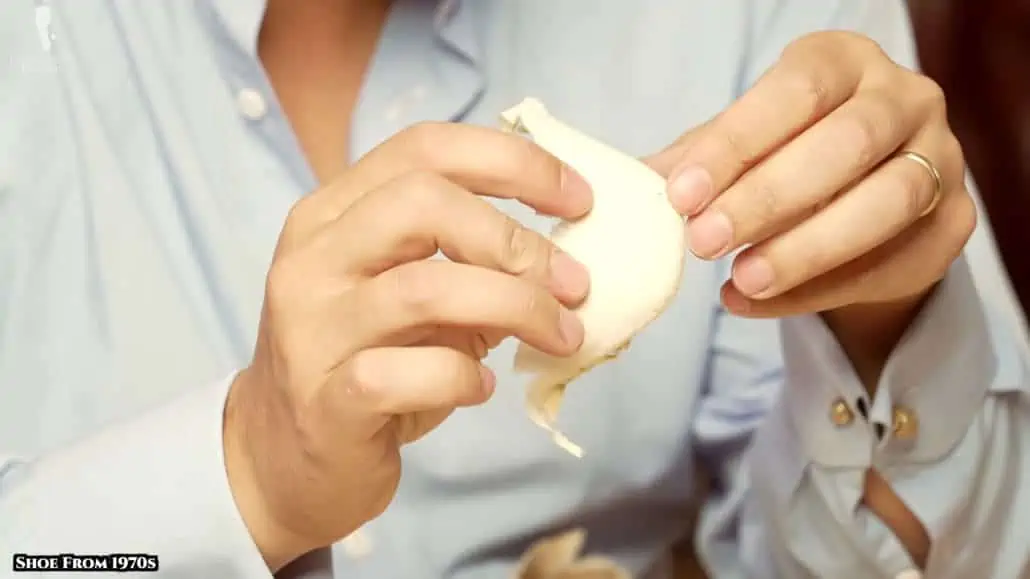
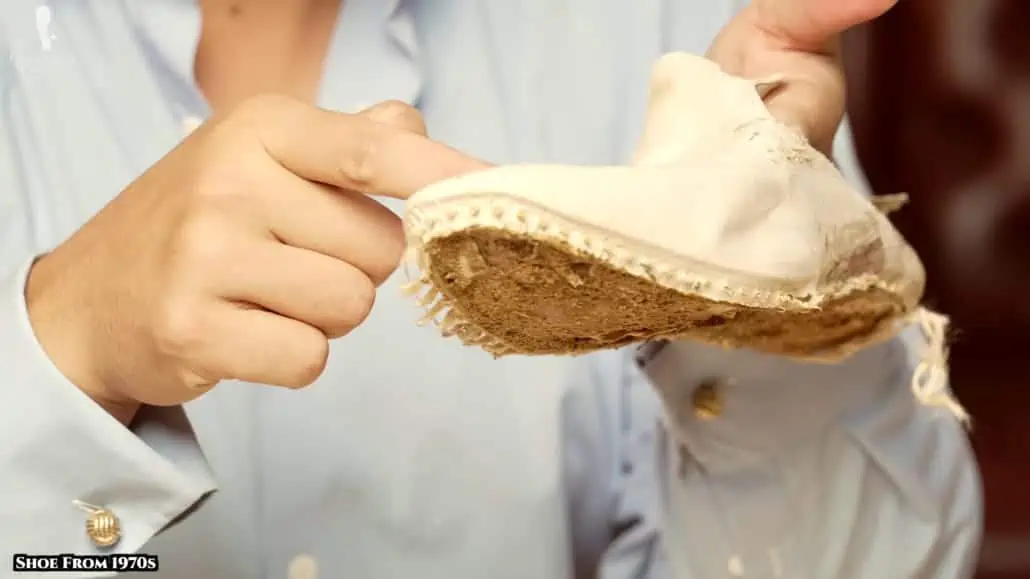
Now the last thing was this really cool-looking strip here and what’s inside of it. Let’s see if we can learn a little more about that. So, this is definitely leather on top, and you can see these strands in here, though. How cool is that?! Must have been a new technology at the time. And now, you can see as I pull, it actually comes off.
Obviously, it was on the shoes. It wasn’t meant to come off the way it does now. It was this like elastic material, and then they took leather, embossed it, knowing that they could. Because the embossing was there, that’s where the leather would continue to crease. It’s a bit like a Saffiano leather,
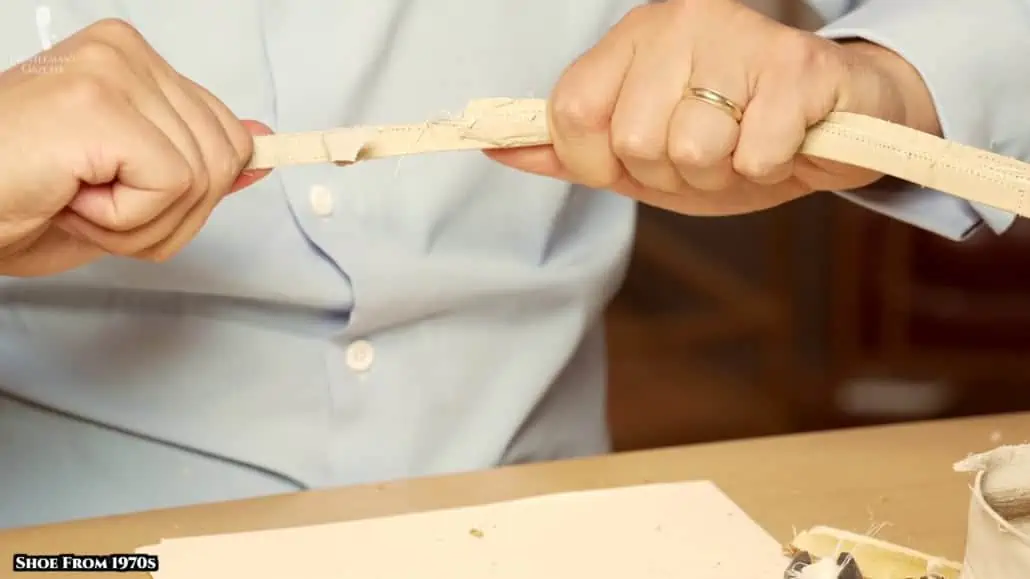
for example, where you should know it’s going to crease, right? So, if you define the crease line you know that’s what’s going to happen, and that’s exactly what they did here. But they didn’t just put a ribbed elastic band there, but they put leather on top there. Pretty cool level of workmanship. I had not seen it before and I appreciate that more.
Now, in here, it doesn’t flex as much because at the bottom it’s all attached, but it flexes a little bit. Pretty cool.
Alright, here’s the kind of welt. Still feels a lot sturdier than yesterday. I think it was also bigger. Interesting!
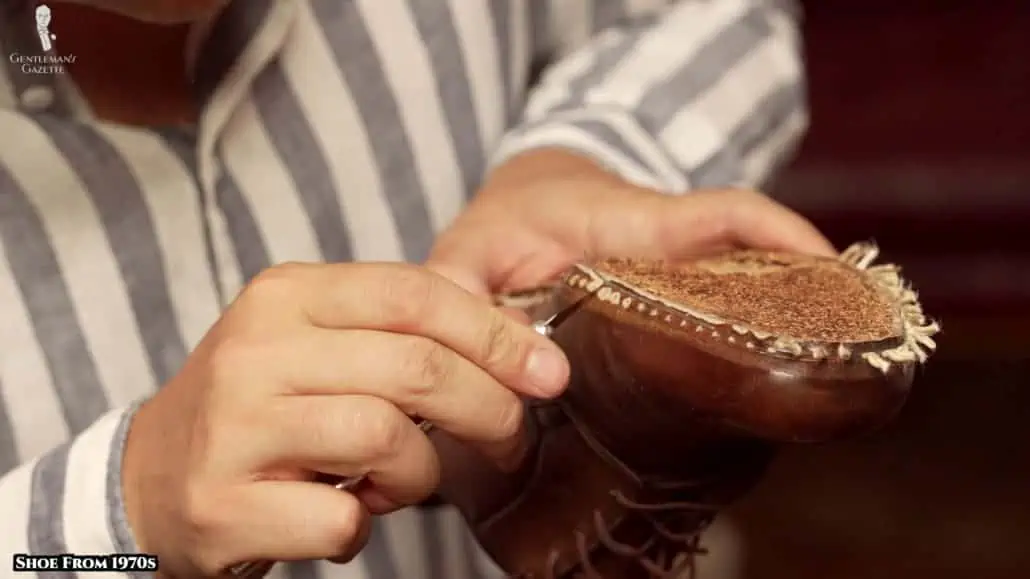
What is that? Almost looks like a plastic strip here that’s built-in. No idea what that was for, to be honest. Not something we saw at the others, and it’s just tacked in here on this side and on that side with a little, little tack. And here you see those little tacks again. So, maybe this one nail was just something that someone added.
Okay, so this is the Leeds’ insole with the gem band attached. I’m gonna take off that gem band now. Yeah, this is just the gem that was just glued on. Leather insole gem band and the cork.
Oh, interesting! This one doesn’t have a leather or linen lining. It had these kinds of perforated leather linings. Still in good shape, as you can see, and the little tags seem to be oxidized inside of here.
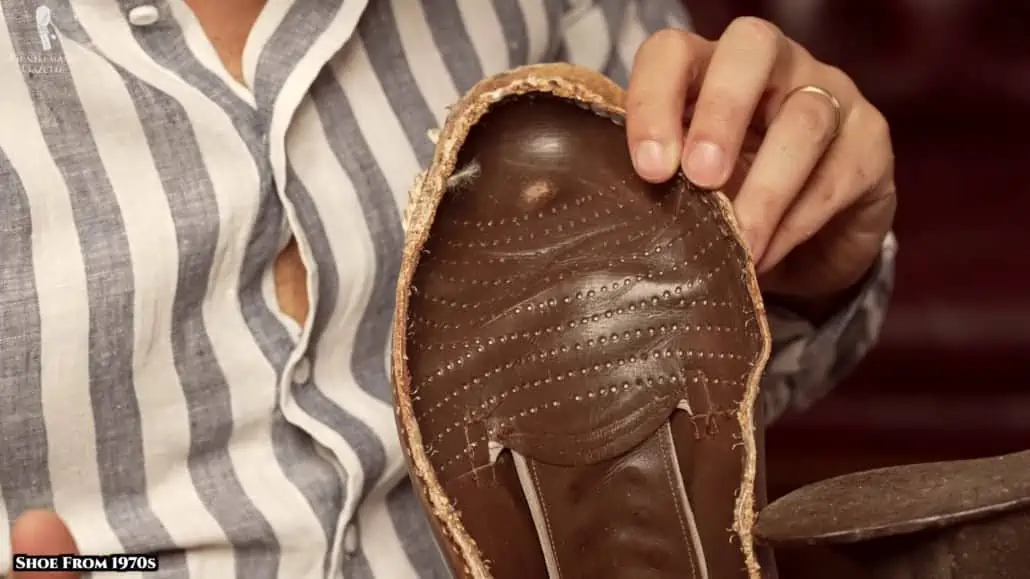
Now, you can see there’s again this interlining, leather lining, fabric interlining; gives the leather a little bit softness upon the touch, upper leather lining. No fabric here in between on the tongue, interestingly. This is a Blucher style, some say blau-cher, so named after a German general or admiral von Blücher.
And up here you can see a piping was attached, a dark color. You also can see here they have it zigzagged at the edge, allowing it to be a little more flexible when it goes along the edges. Pretty cool stuff!
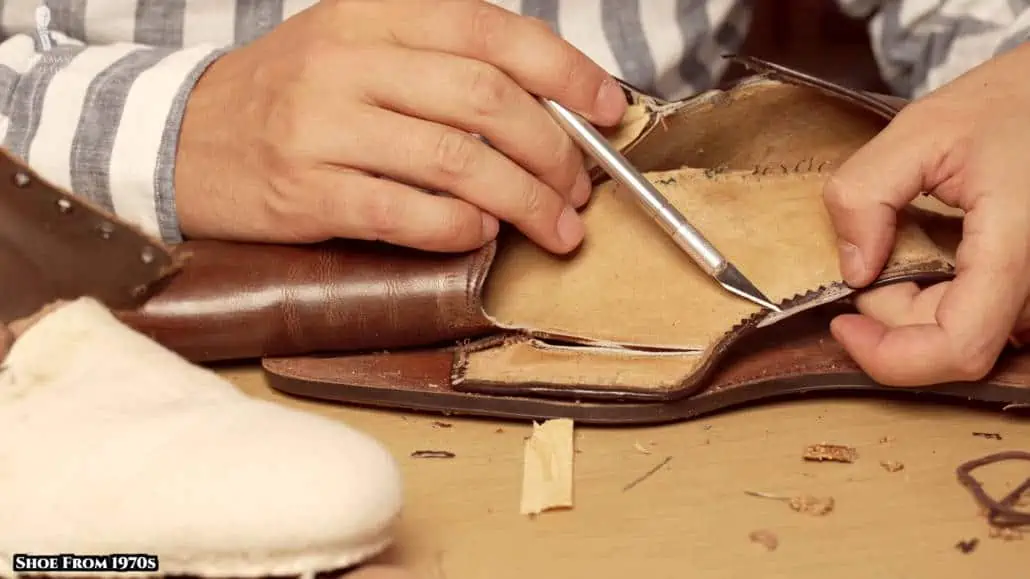
As far as the upper leather goes, you can see, you know, the layer on top it’s lighter underneath. It has this kind of, nice kind of a hatch grain pattern. Seems to be, to me, like good-quality leather. After all these years, it’s obviously a little more brittle, but it still feels nice and supple.
Okay, otherwise, here is the lining, obviously. So, you can take that apart and we see, again, this heel cap. The tape actually came from here. I just taped it over. These are just sewn together and kind of cut straight and taped over the lining, the shoe, with this stiffened toe cap and this kind of leather paper-ish feeling heel cap. And then, here, the allotments label is sewn in, so you see it from the front.
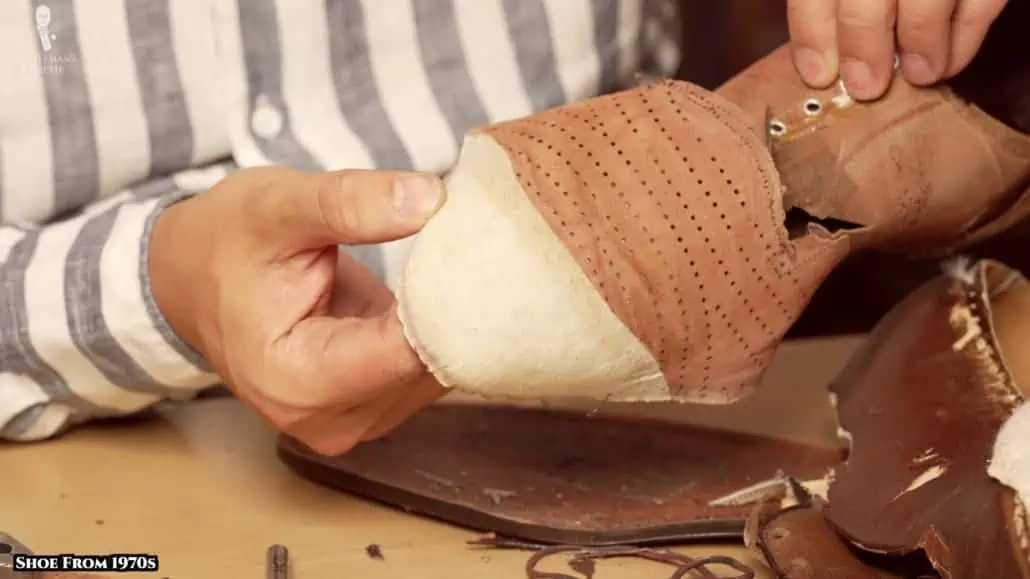
Our Final Thoughts
So, overall, what did we learn? We had one outlier: this Sanibel shoe here, which almost seemed like it was made in a different factory. I know that all the hand-sewn, typically, is done in the Dominican Republic these days. I don’t know if these were outsourced or made in Port Washington.
The thing says “Handcrafted in the USA.” I have my doubts based on the fact that it’s a shoe that’s very different.
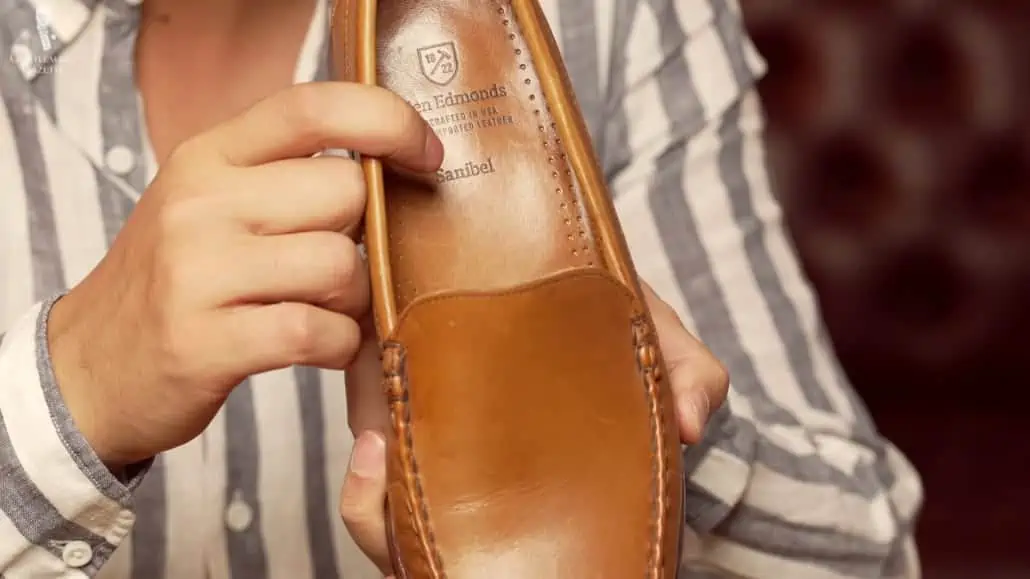
Otherwise, the other five here, are pretty much similar in construction. They use the same tags from here to here. They use the same nails from here all the way to here and back, which I find impressive. The welt, the construction is all pretty much the same.
Yes, they use a different machine here than they did here. Otherwise, though, if you look at the others. It’s all kind of the same machine channel. Effectively hasn’t changed much. Here in the old shoes, they have a different last shape.
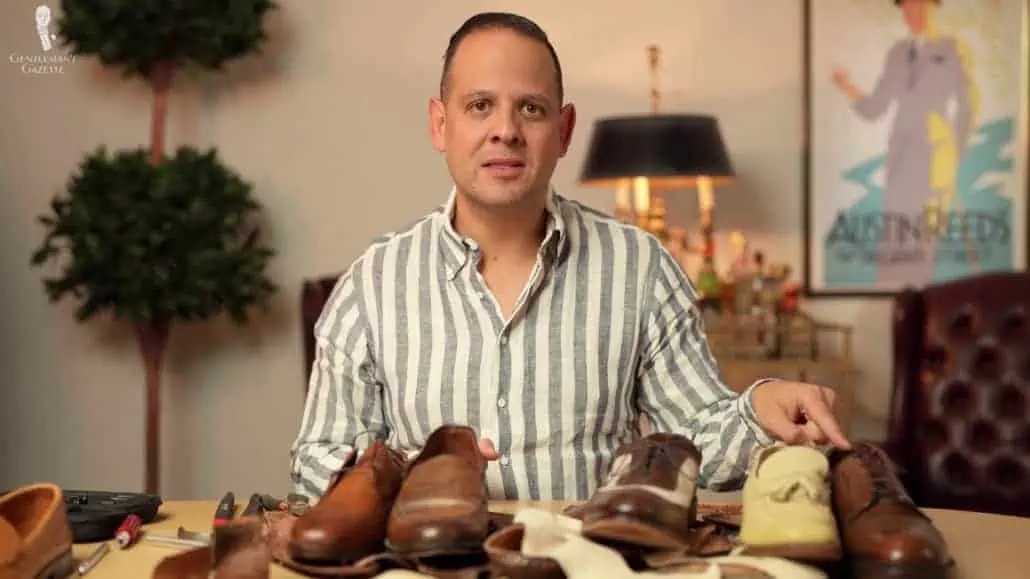
The new Leeds are still around, a little more updated, more than last. I think they reduced the fabric interlining between the leather lining and the uppers. Just felt a little more supple when you touched it. We don’t have that anymore.
Otherwise, the leathers may be a little stiffer, but it’s just a matter of preference. These are quite soft. I’m sure you can find softer, too.
The level of workmanship is a little finer here. Stitch density is higher. They had these, you know, leather that was embossed and folded around an elastic. You had this Ostendo heel, which was this kind of blackish material. I don’t know exactly what it is, but it was supposed to be a comfort heel.
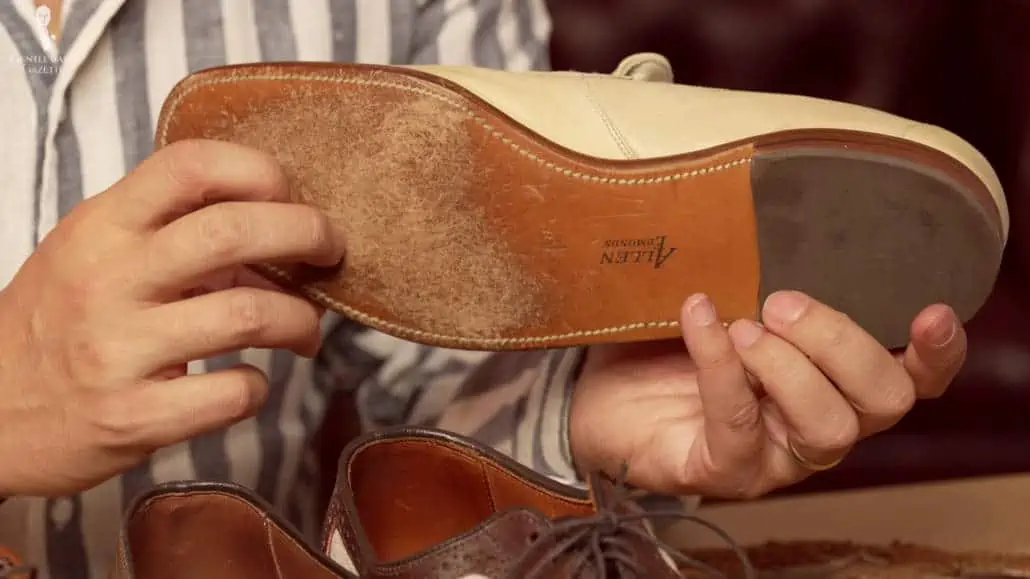
So, no shank here. No shank here. These two have the Allen Edmonds’s wooden shank that helps a little more when you kind of move. This area stays a little straighter versus here. I think, over time, as you stand and put pressure on it, it may sag a little more.
At the end of the day though, you can buy Allen Edmonds with confidence. The claims that, you know, from this shoe to that shoe, the quality has declined is not true from what I can see.
Yes, they use a sock liner all the way through and a little foam pad, but it doesn’t hide any, like, solders of inferior quality. There’s still a leather sole underneath of it you can rip out the sock liner and it’s all good, so you’re still getting a good quality shoe. Their lasts are a little bit boxy and not as refined in my mind.
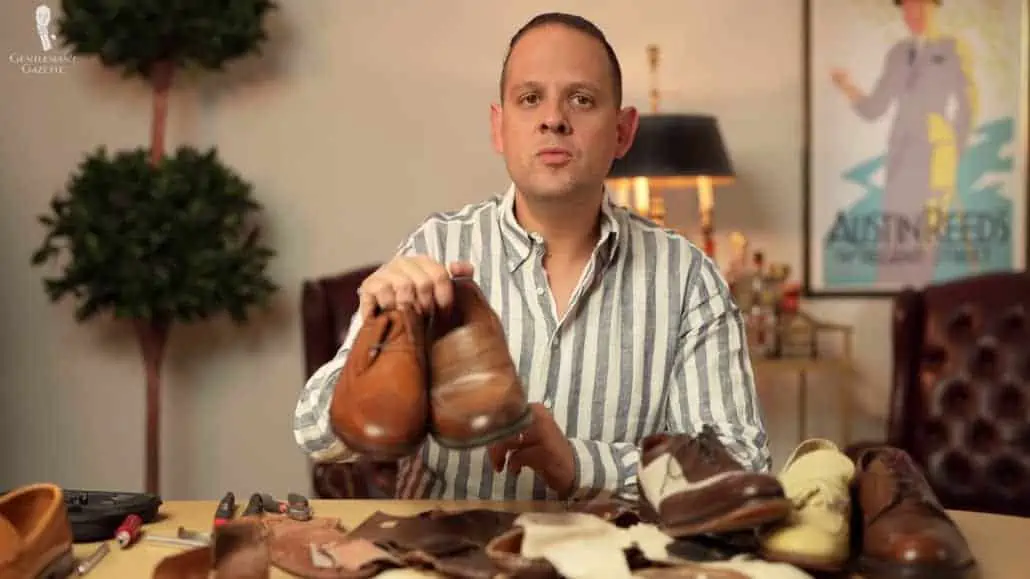
But, at the end of the day, if you like the look, you get a quality shoe that can be resold and rest assured that the quality level has only changed ever so slightly from 50 years ago, which, in terms of shoes, is a good thing because mass factory mage shoes typically have become a lot worse since then.
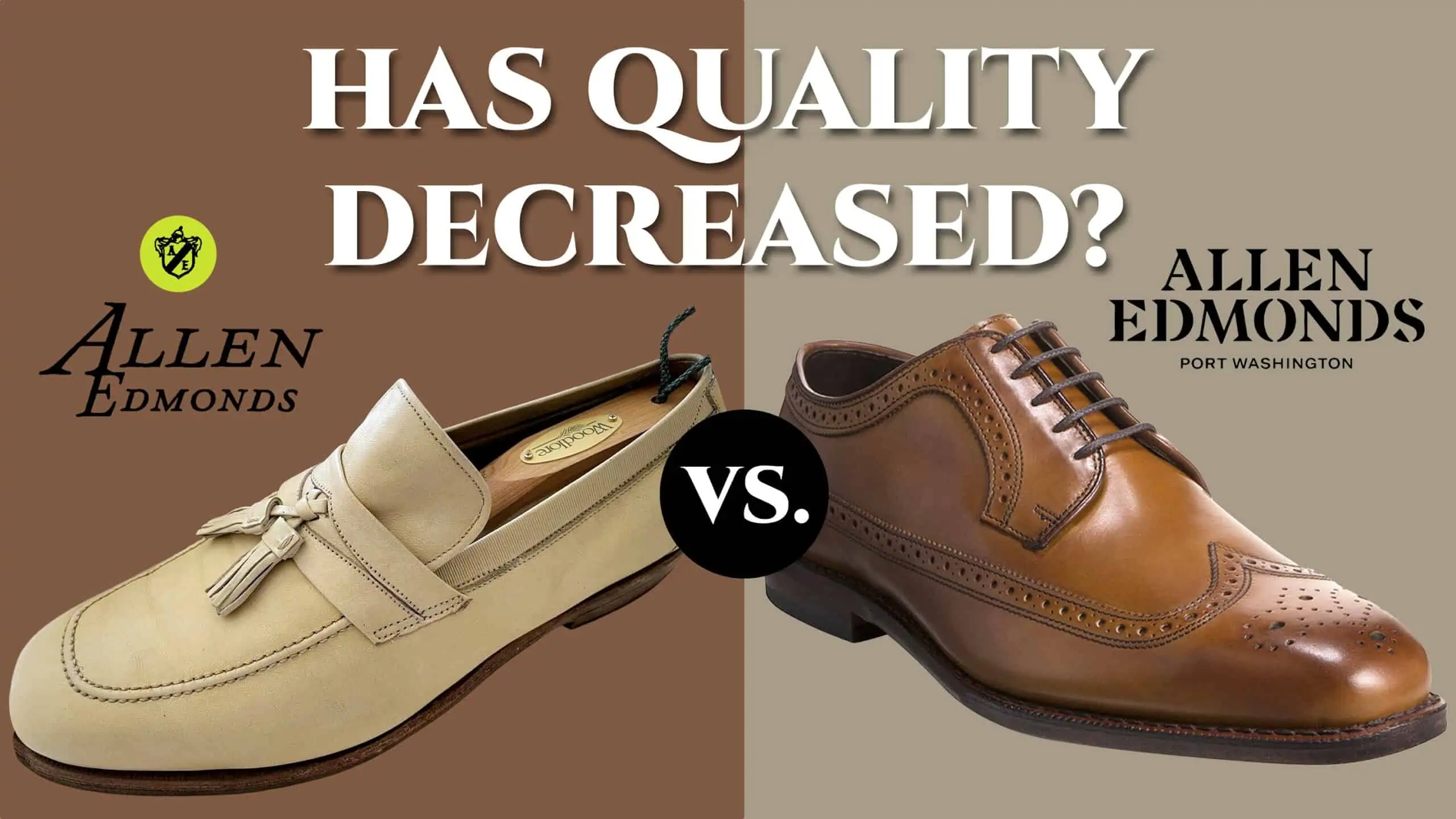
To me the Allen Edmonds dress shoes from the last 3-4 years feel lighter and less substantive than those I have from 15-20 years ago. Also, I detest burnishing and it appears that virtually all Allen Edmonds dress shoes except solid black are now burnished (and don’t tell me I “can always remove it”, I had my fantastic shoe repair guy try that, and it was ok at the first, but 6 months later the burnishing is back like the Terminator).
I currently only 10 pairs that accumulated over the last 10 years or so. I have been an Allen Edmonds wearer since 1995. The last two brand new parasite bought was during the pandemic and yes I agree the quality has deteriorated a little bit. One thing that I do miss are the old Allen Edmonds footbeds. This is a great Brand I hope they’re able to fix everything and turn it around.